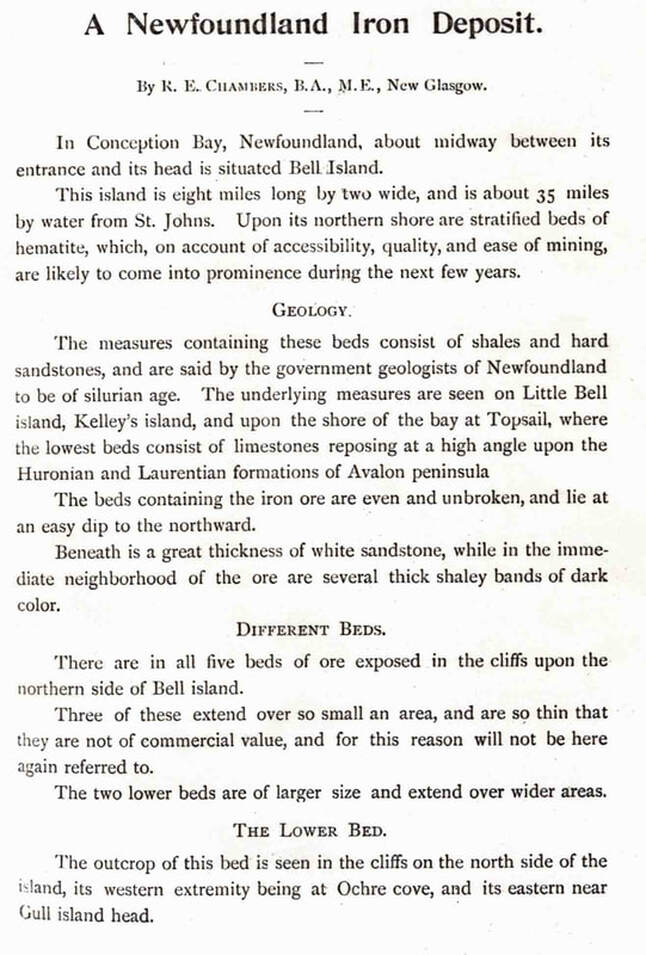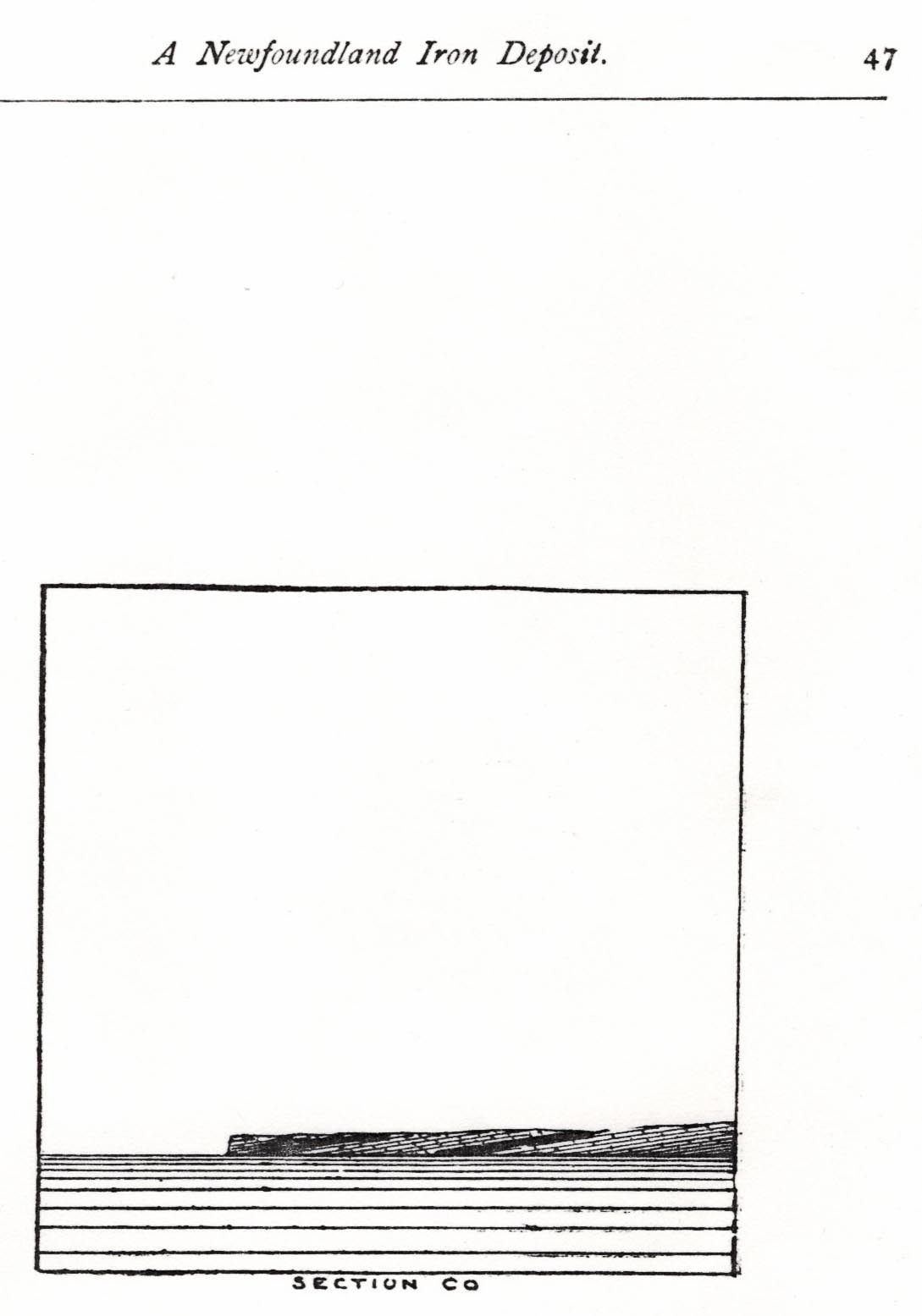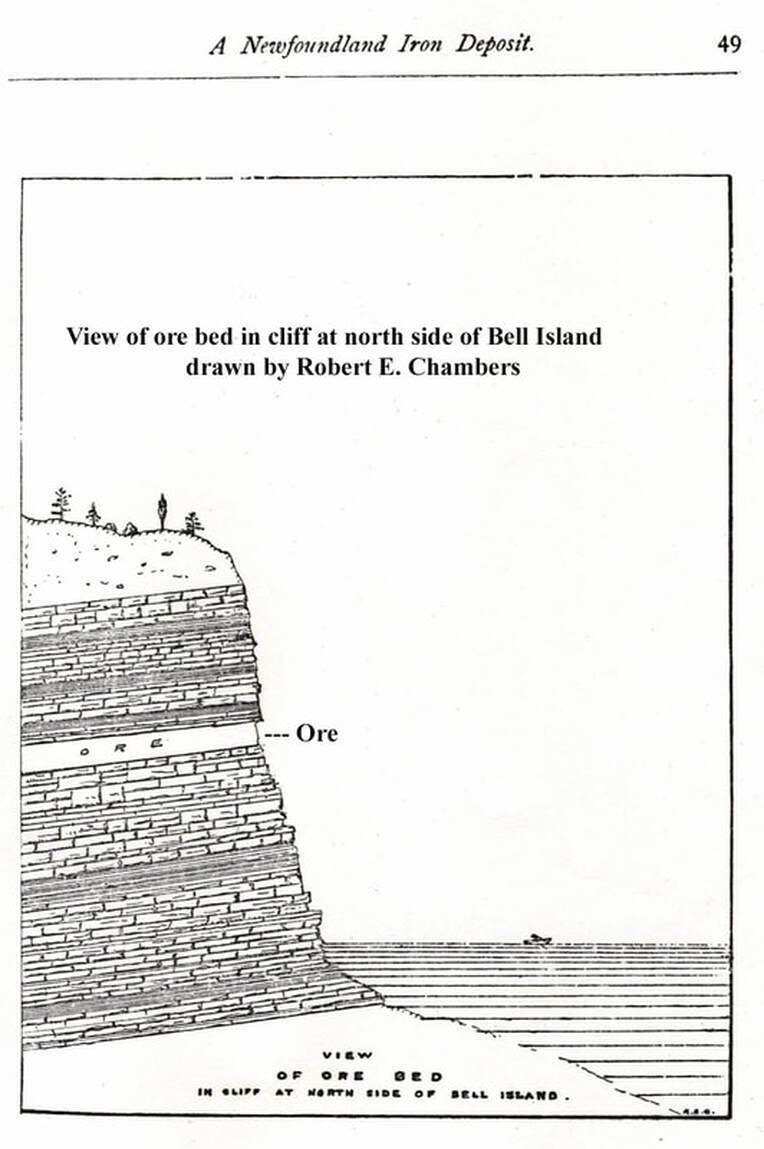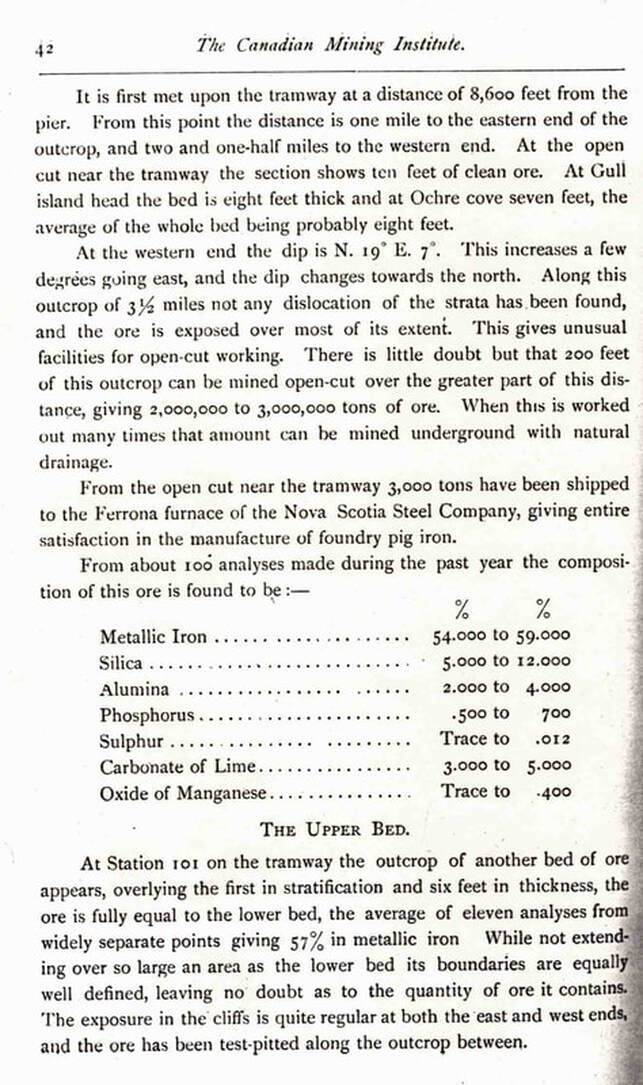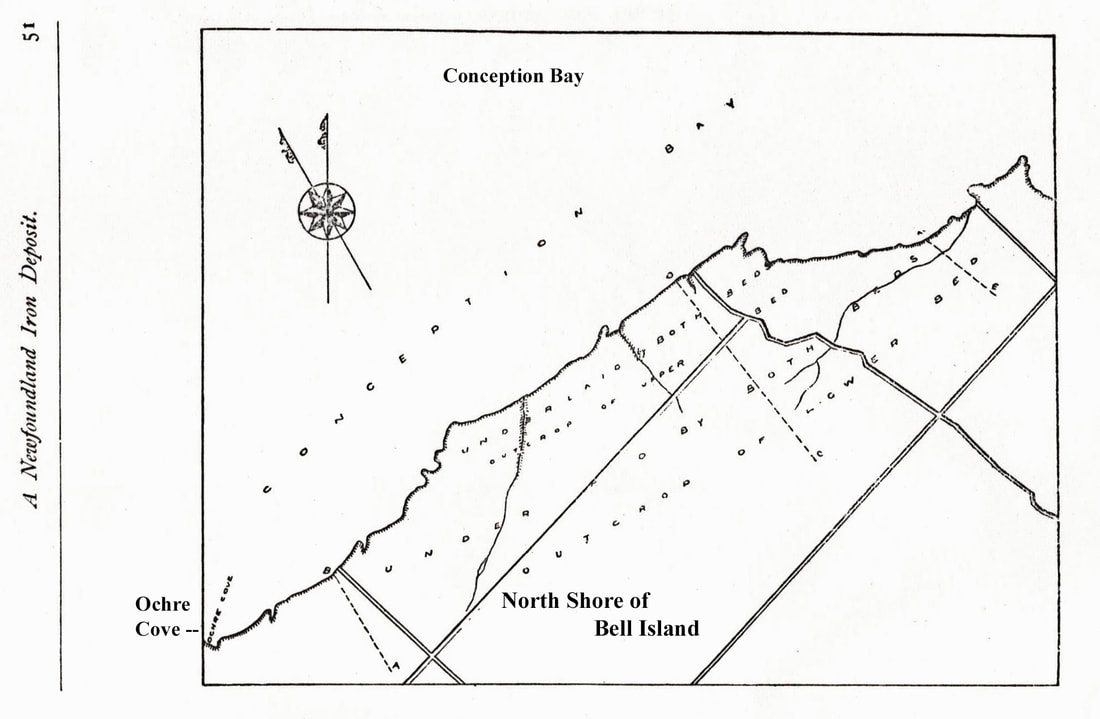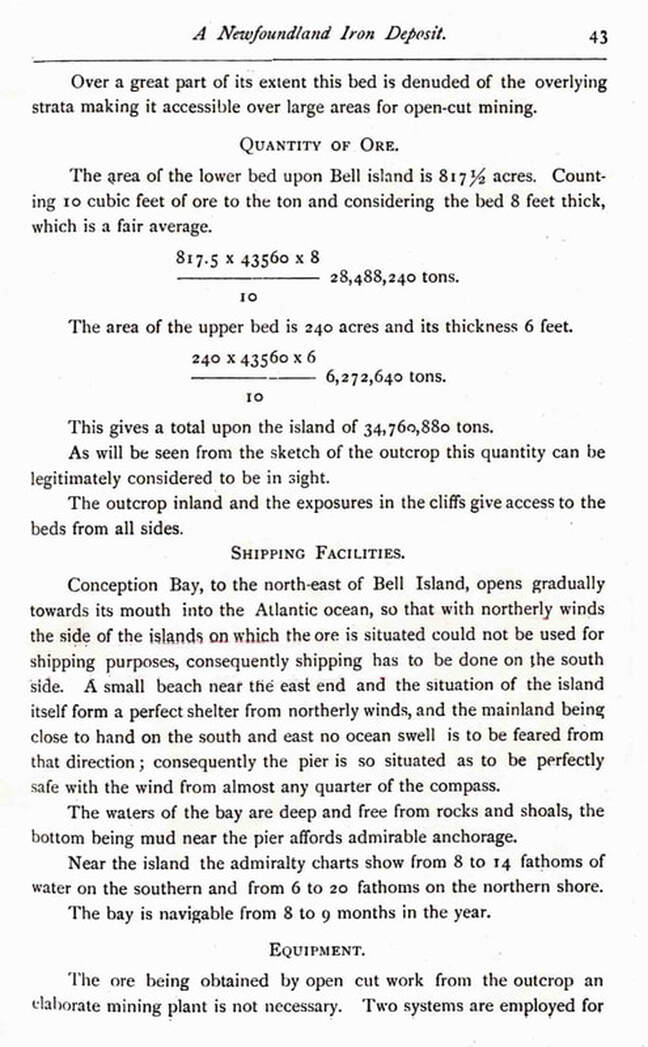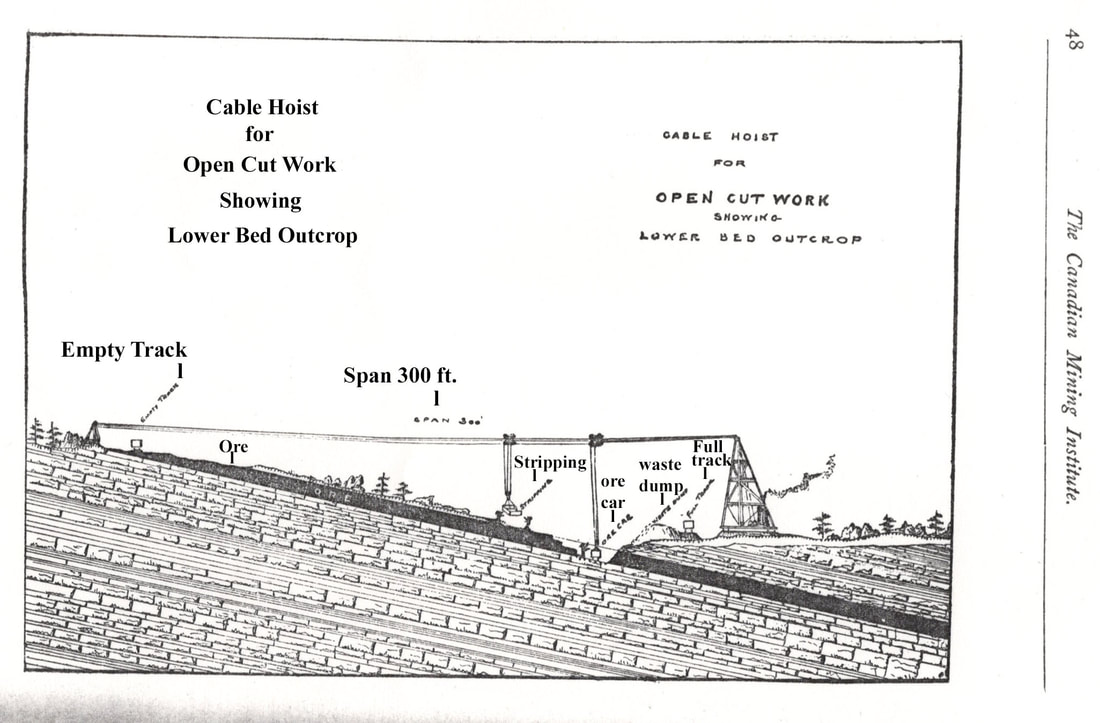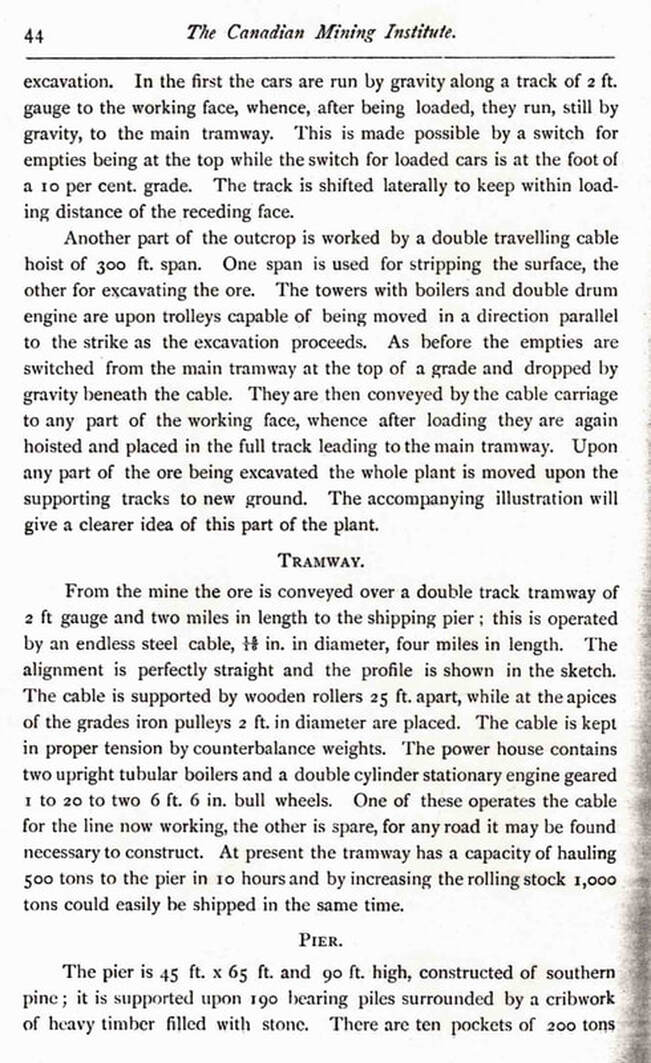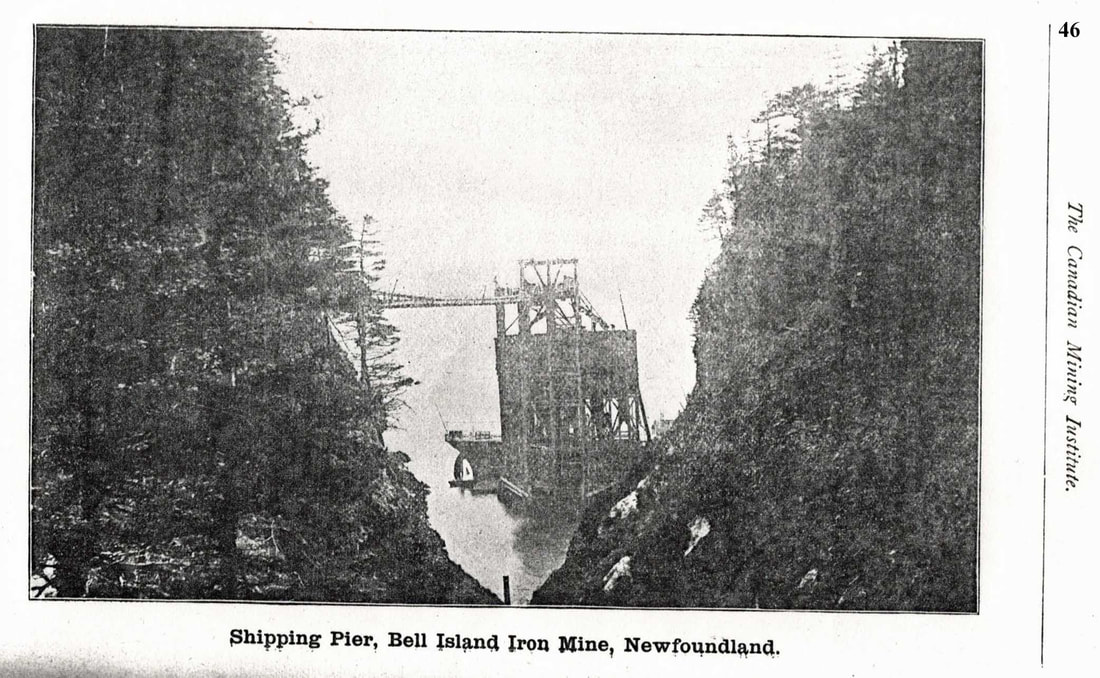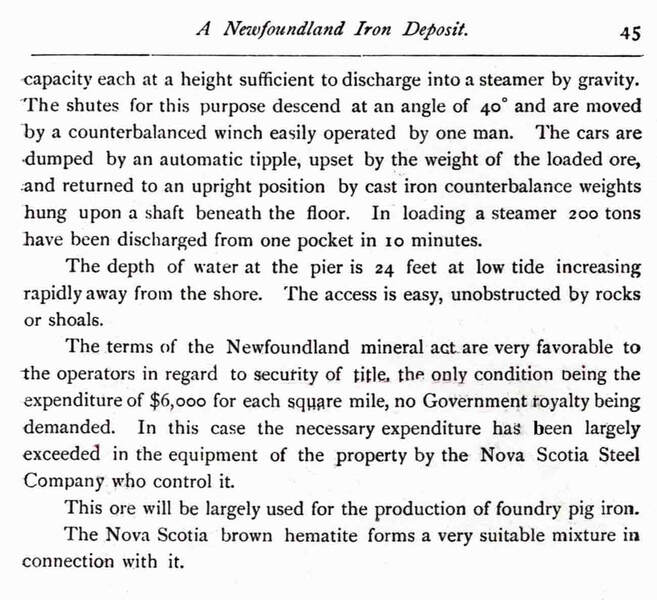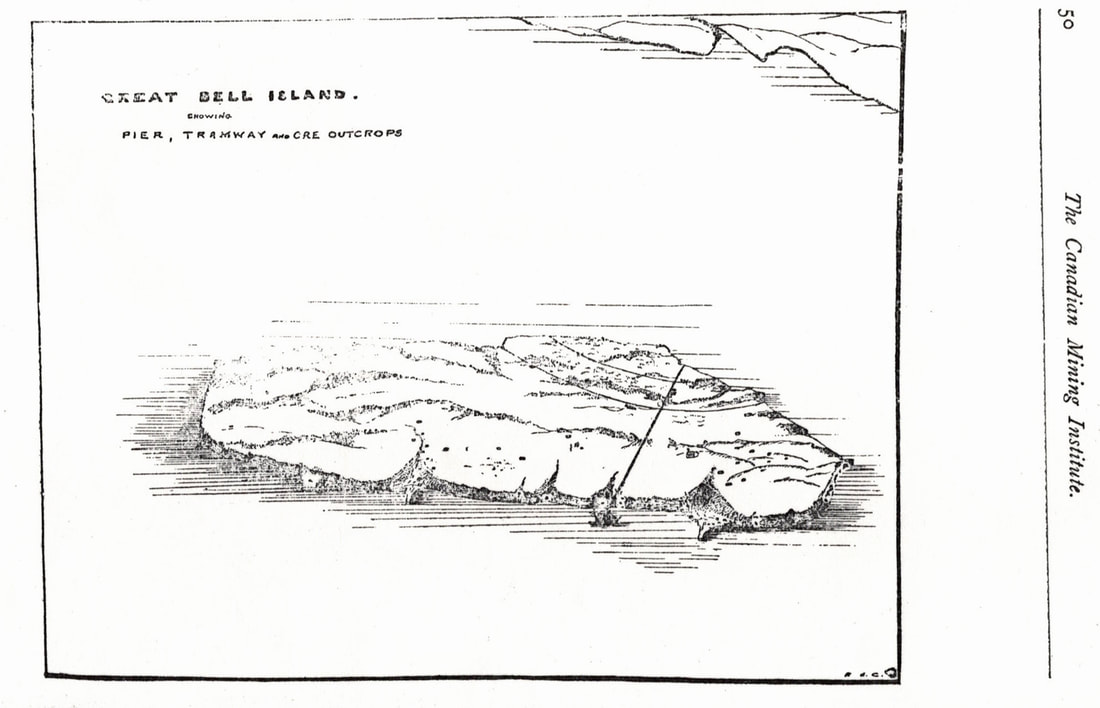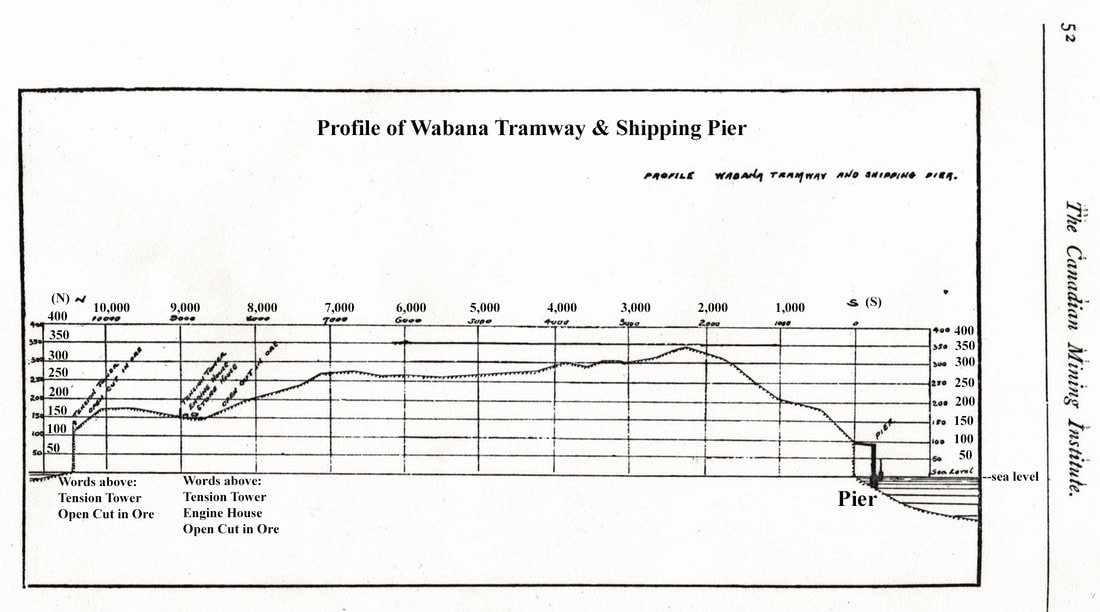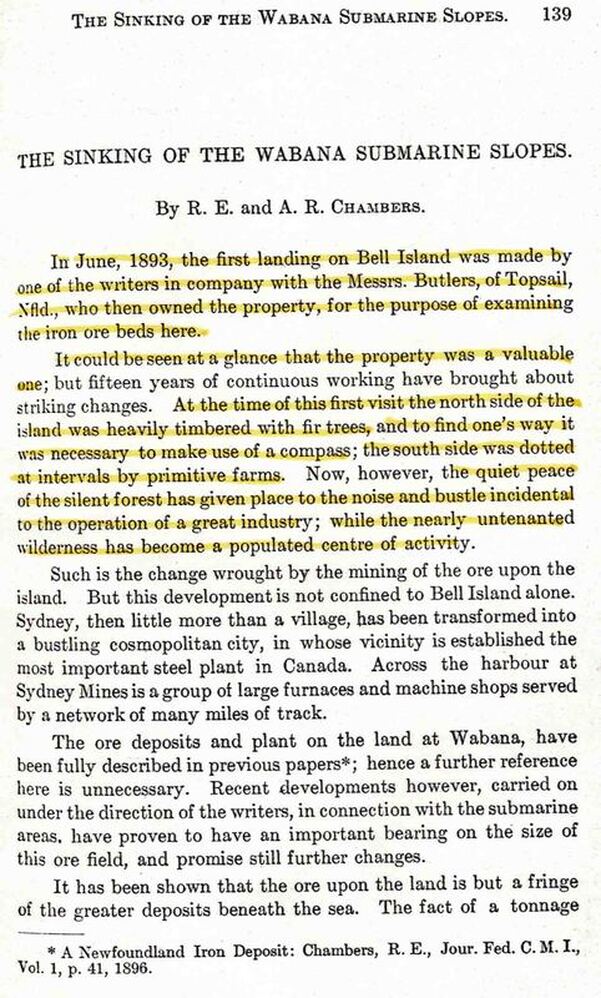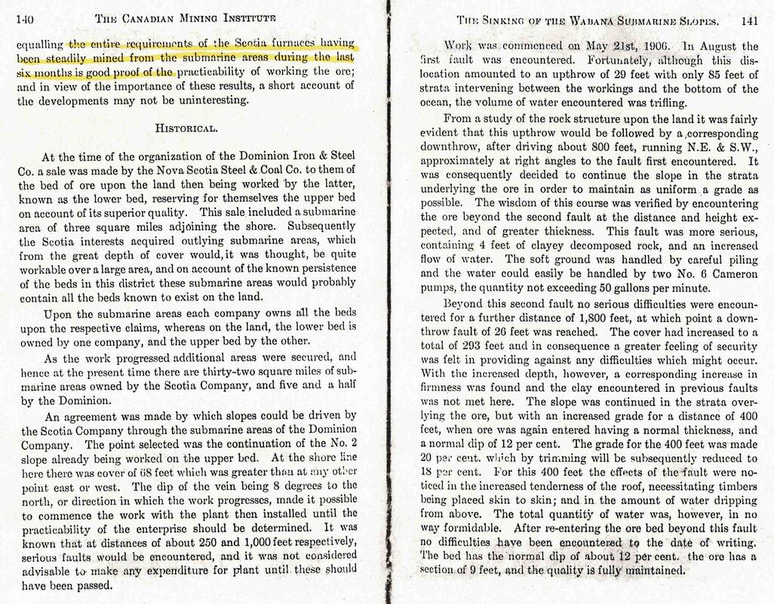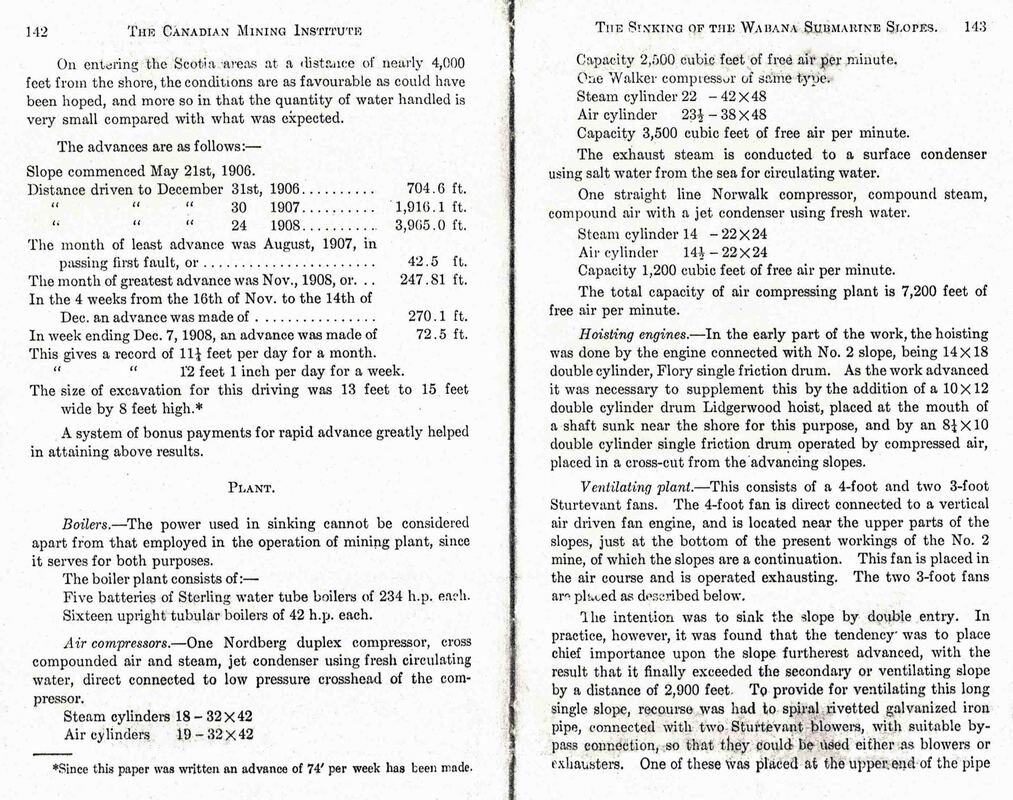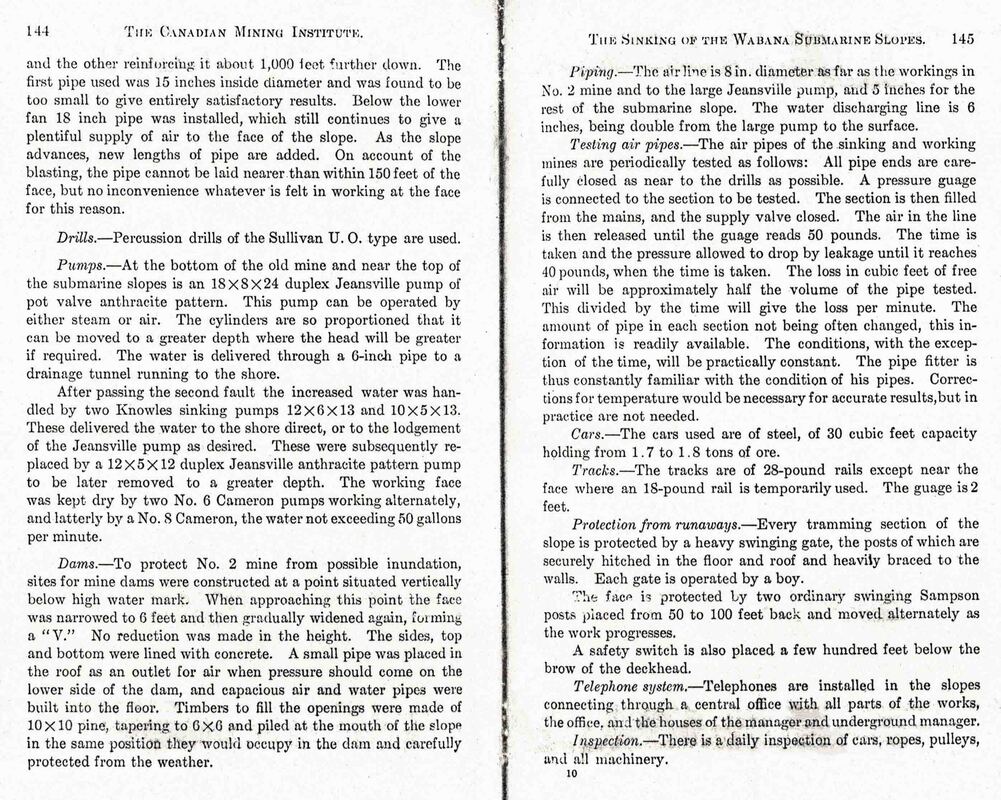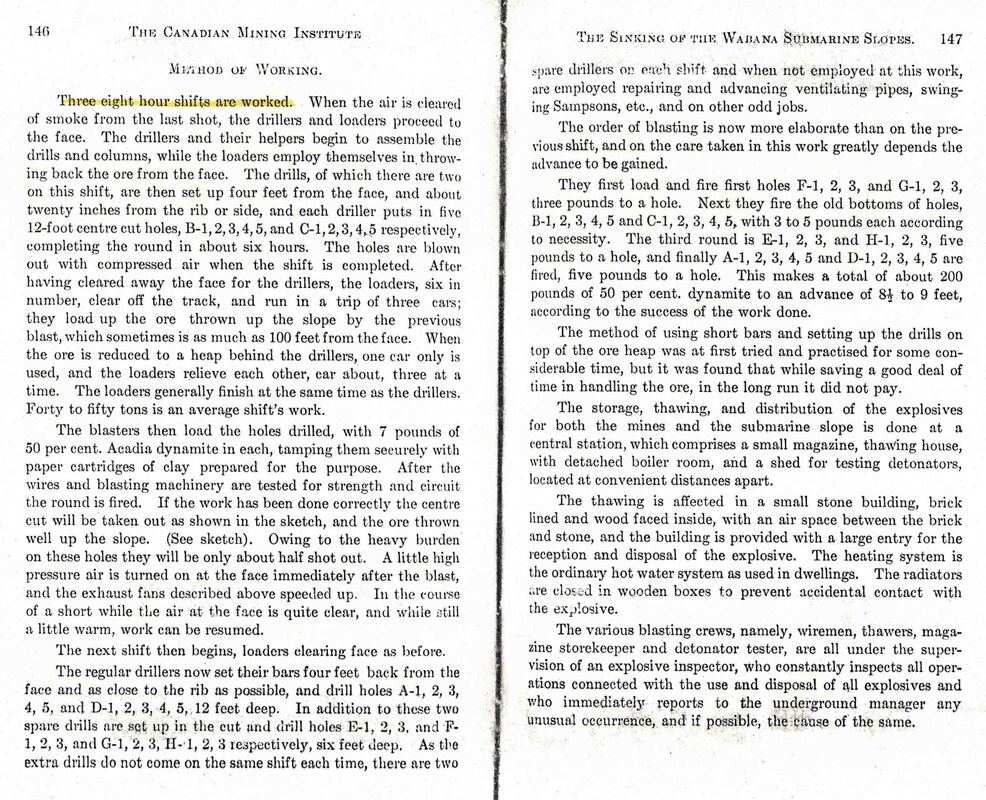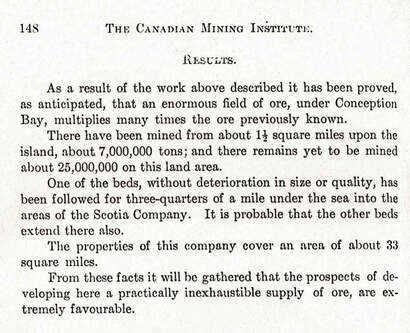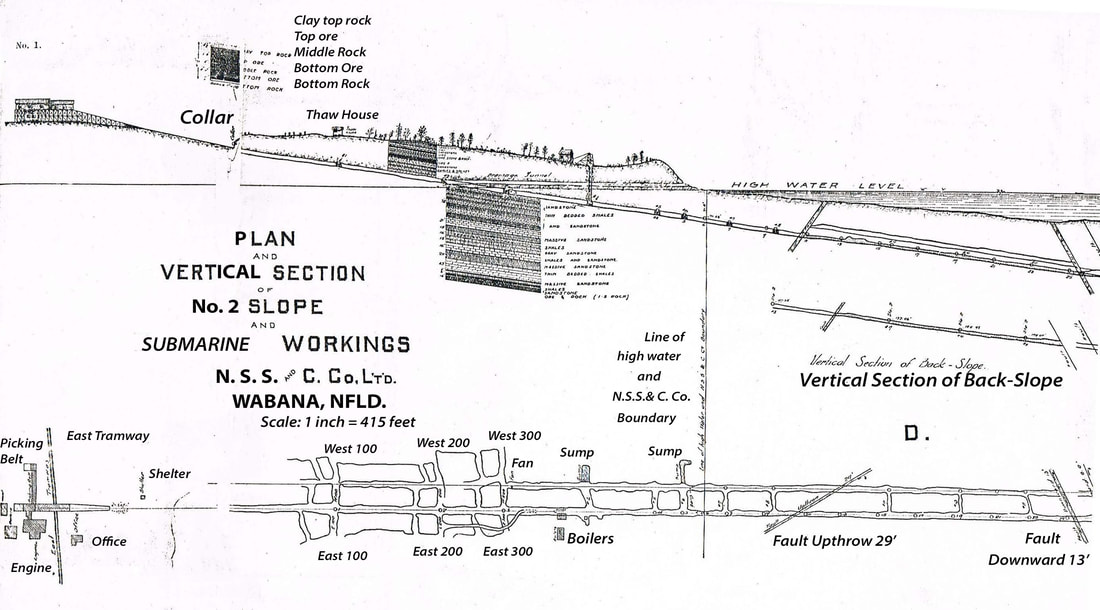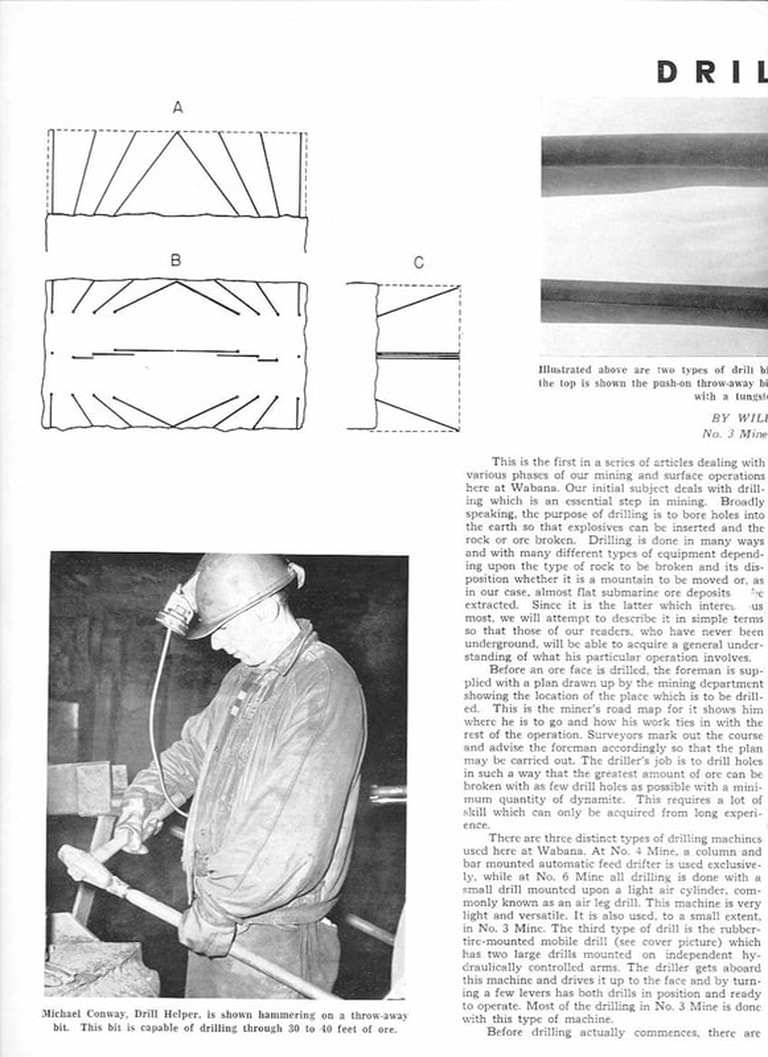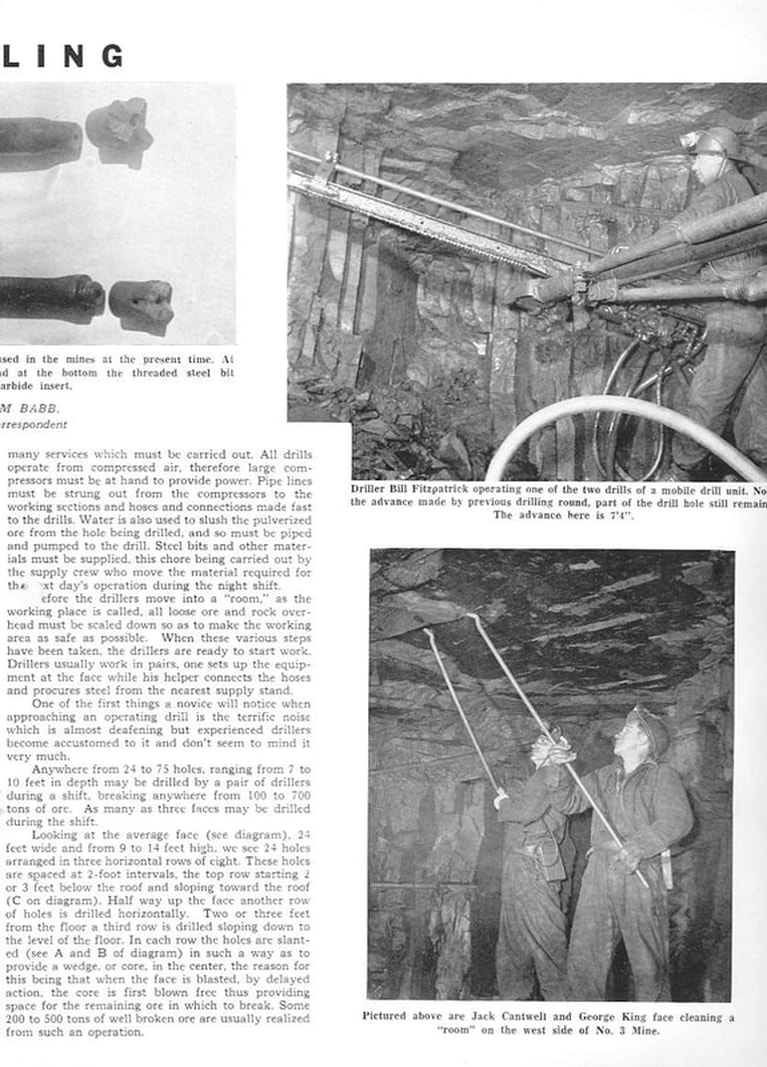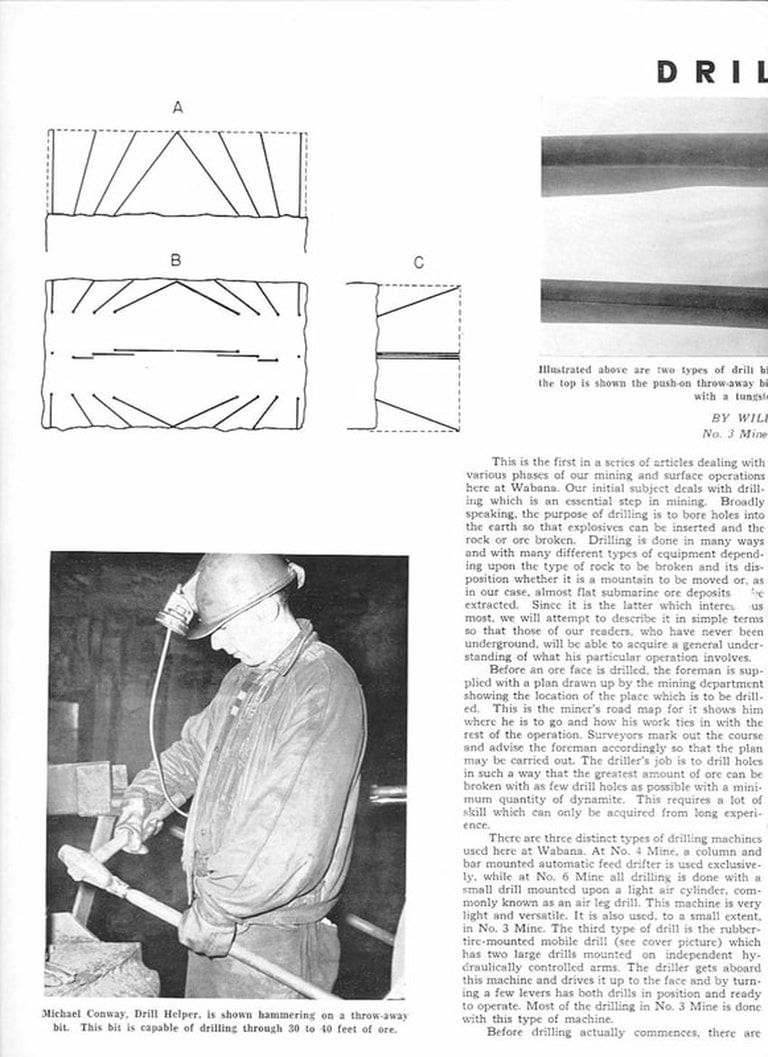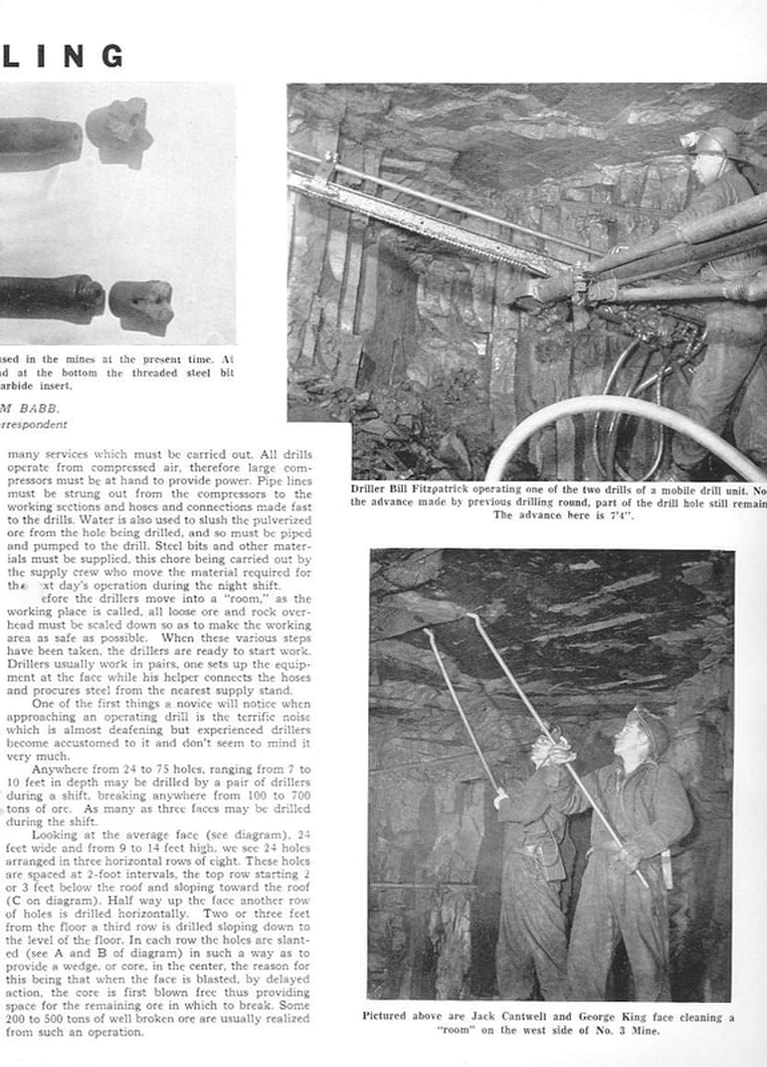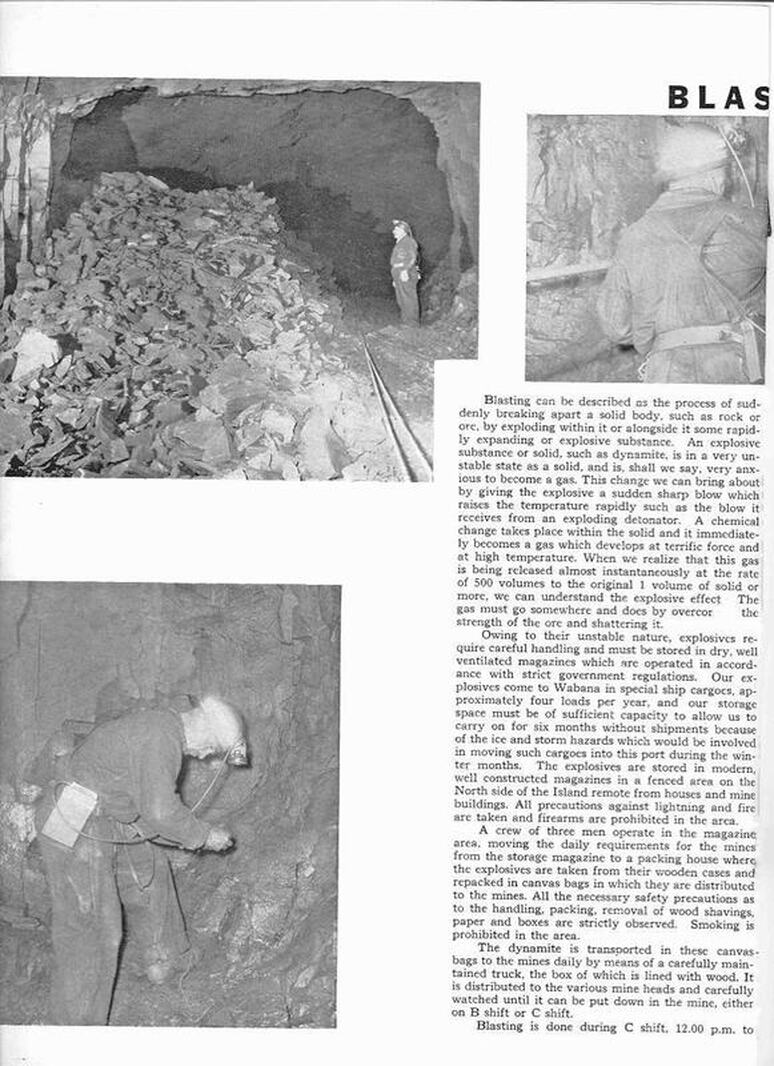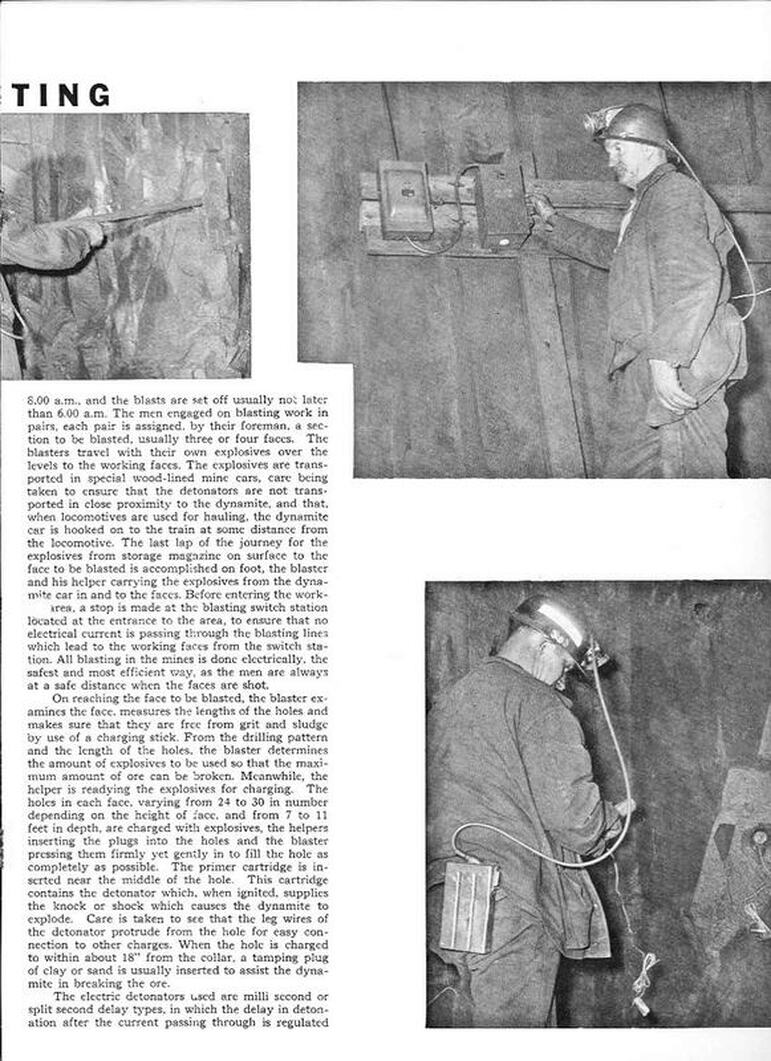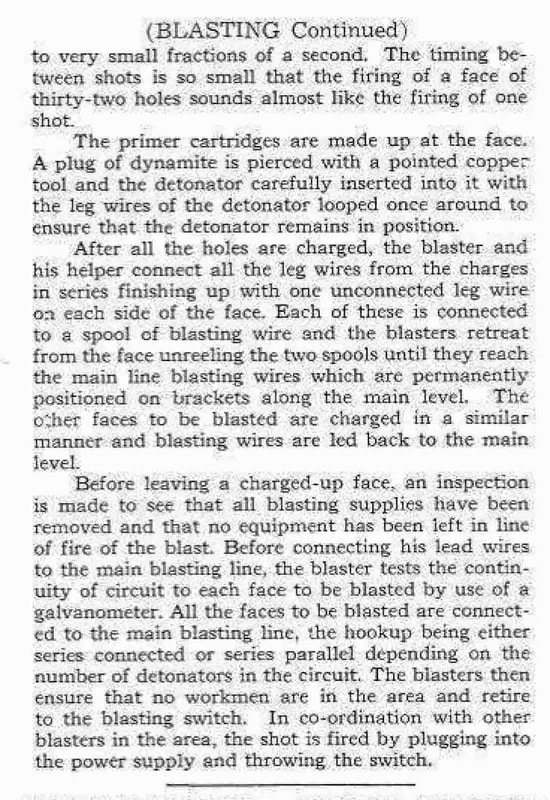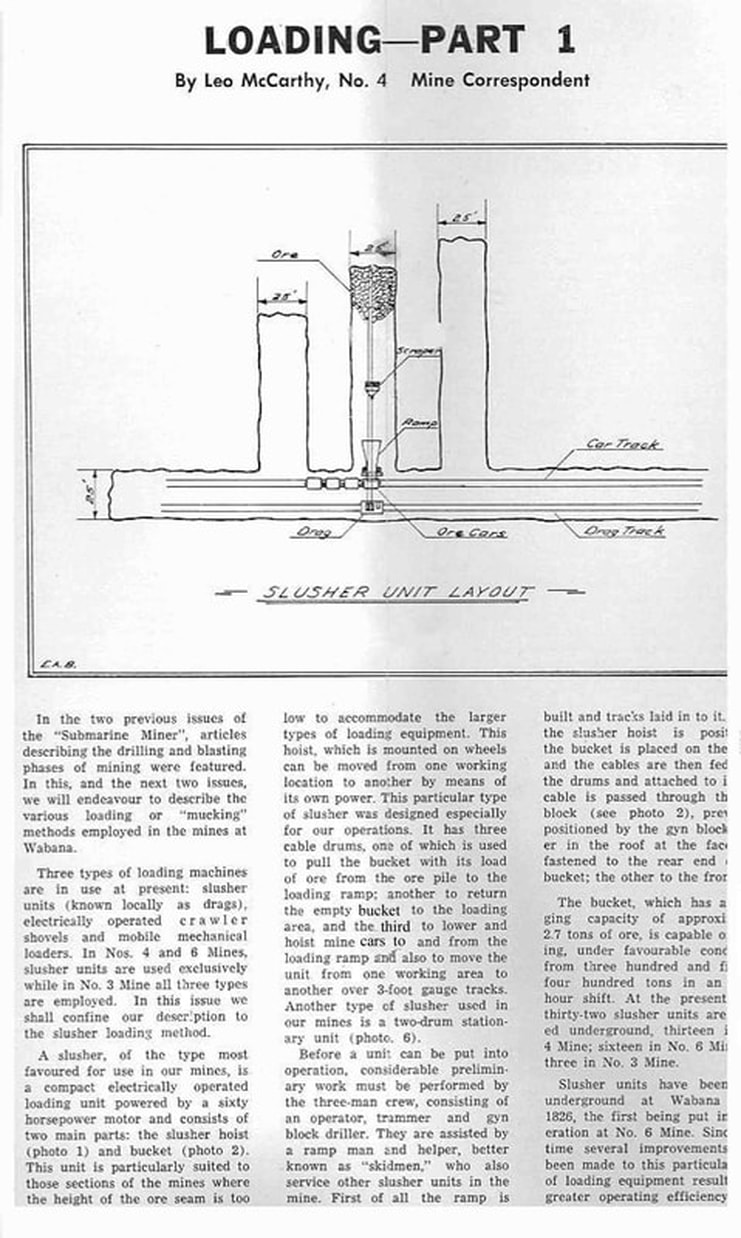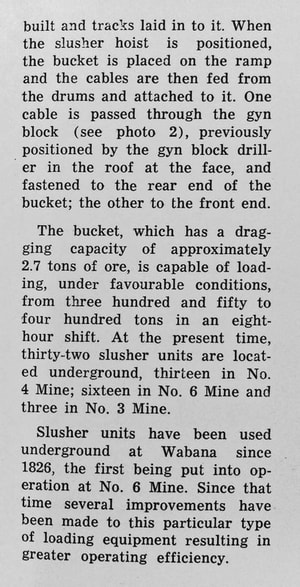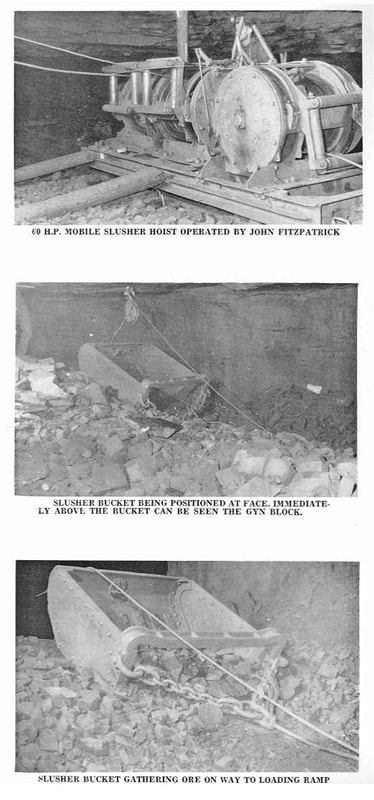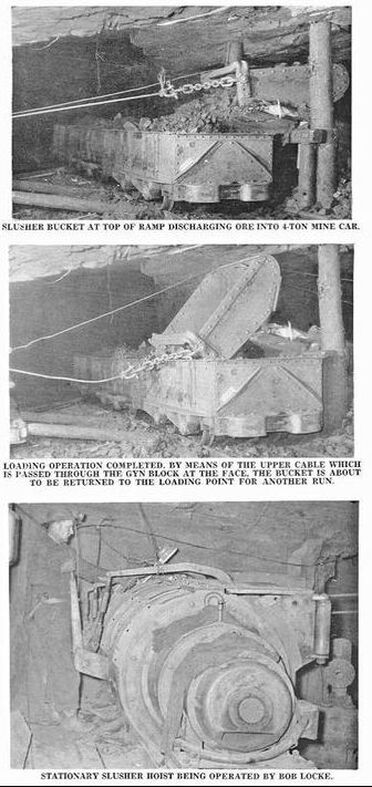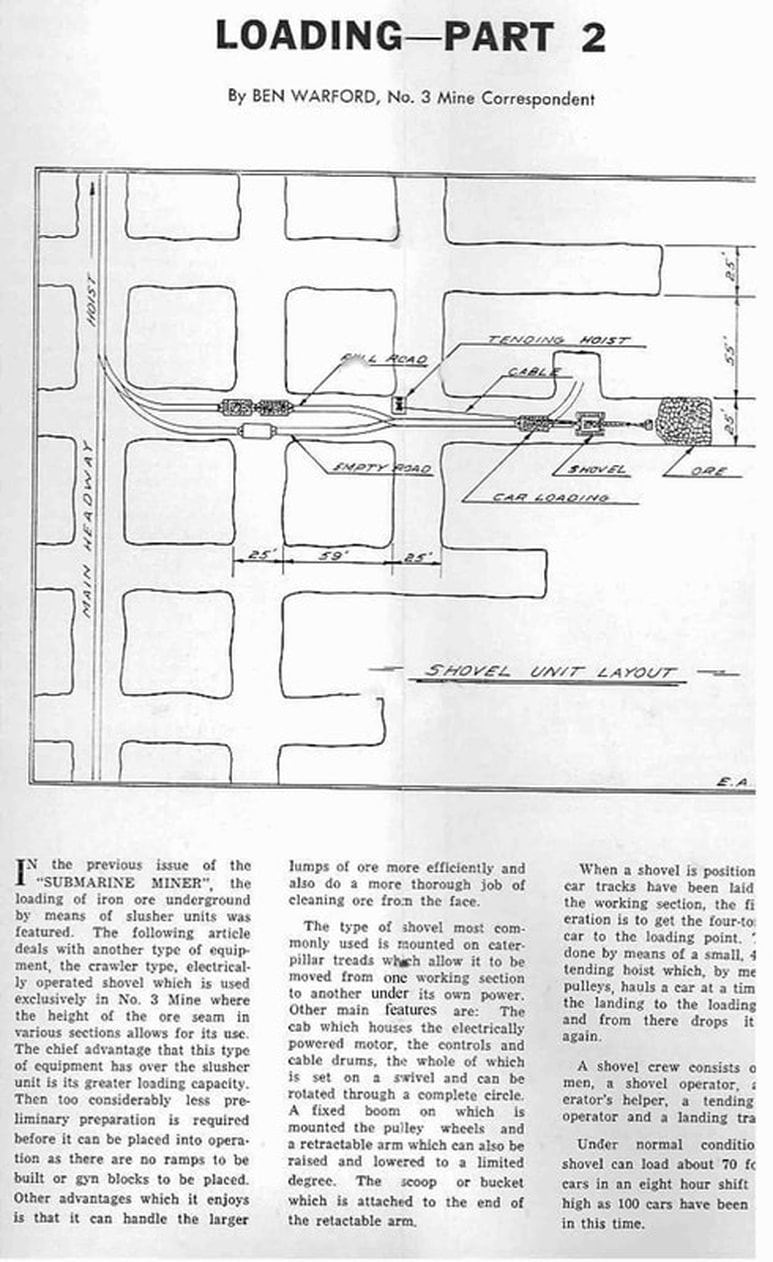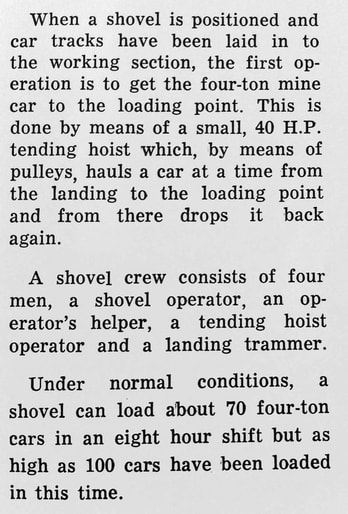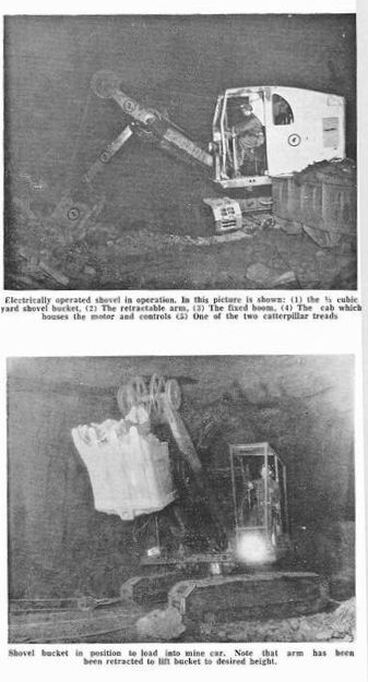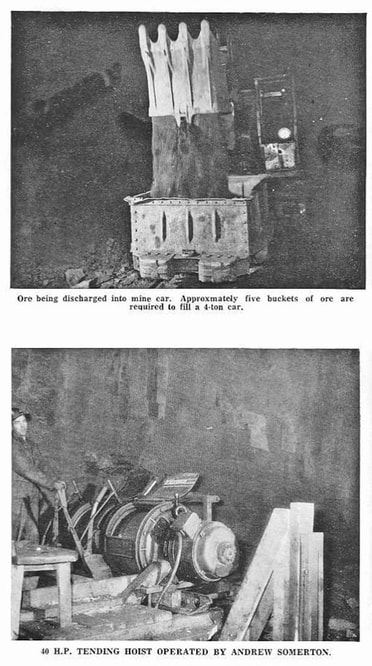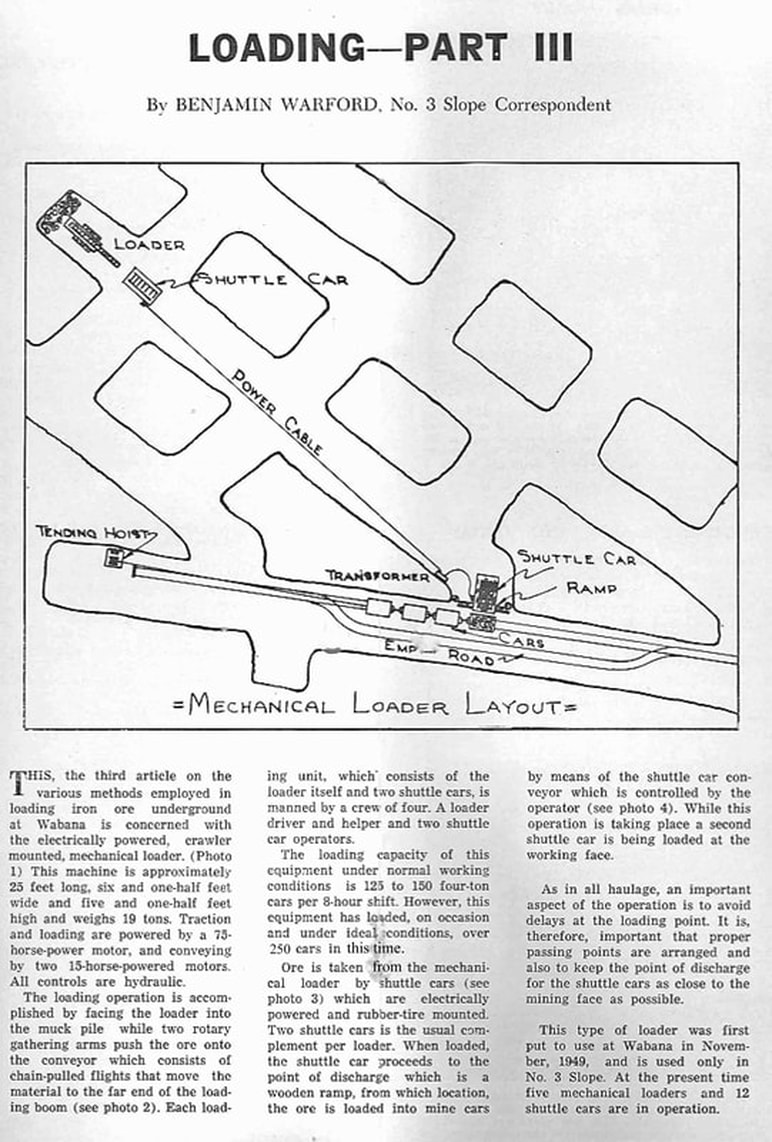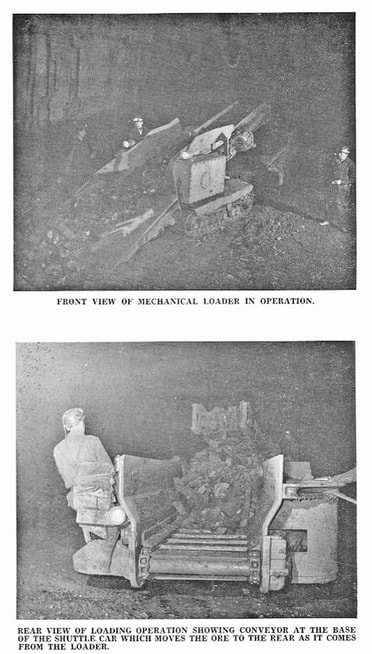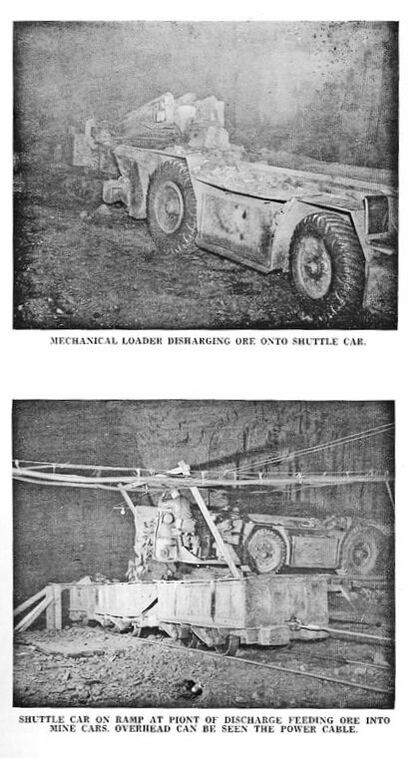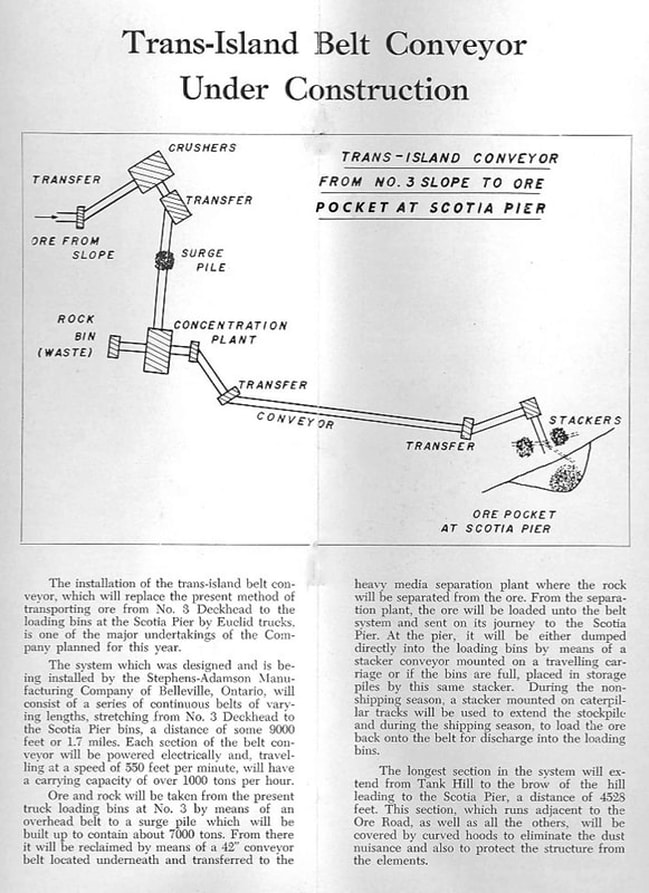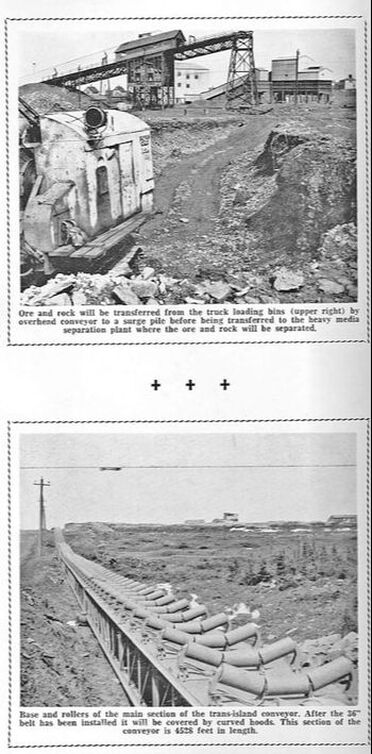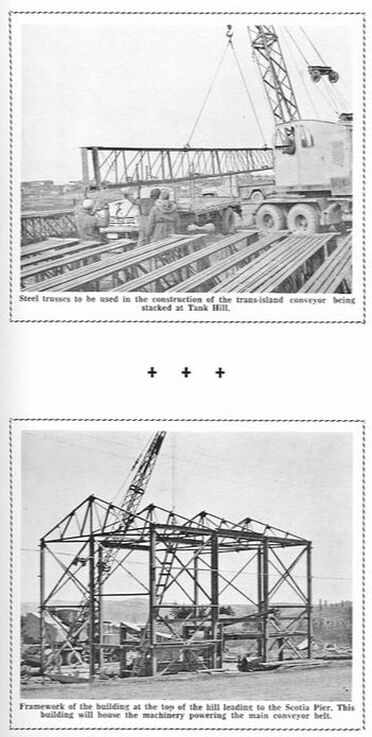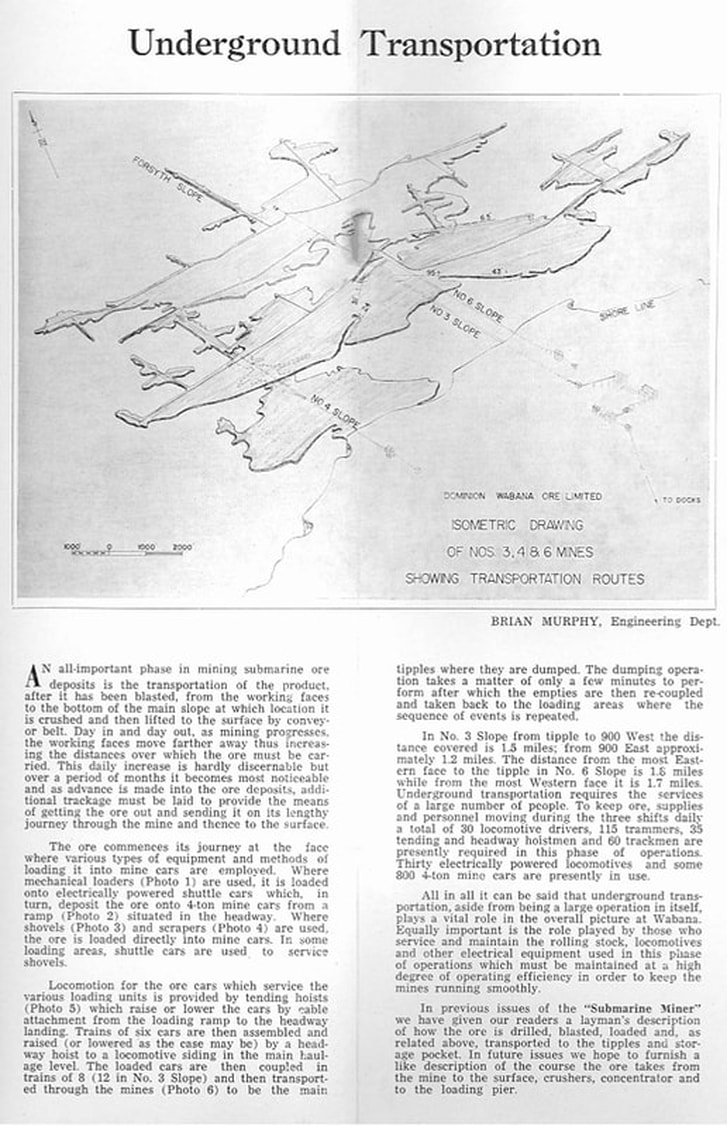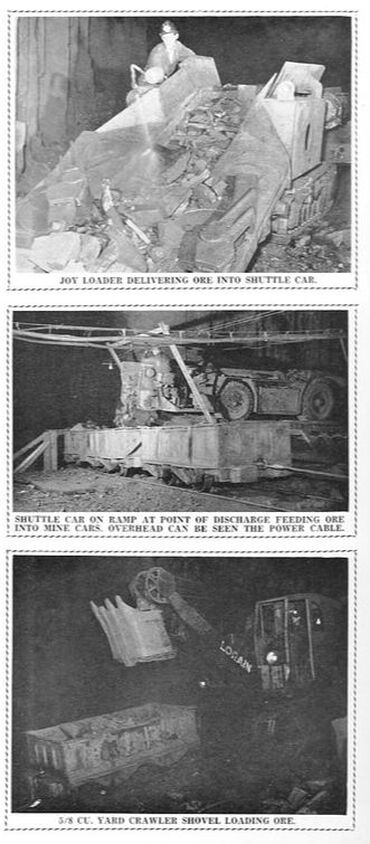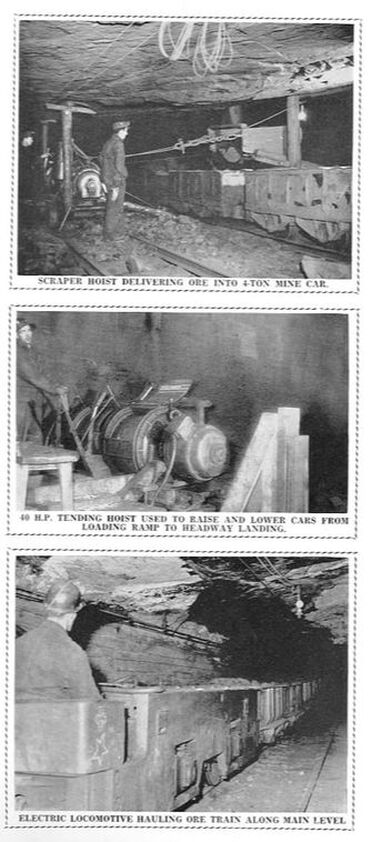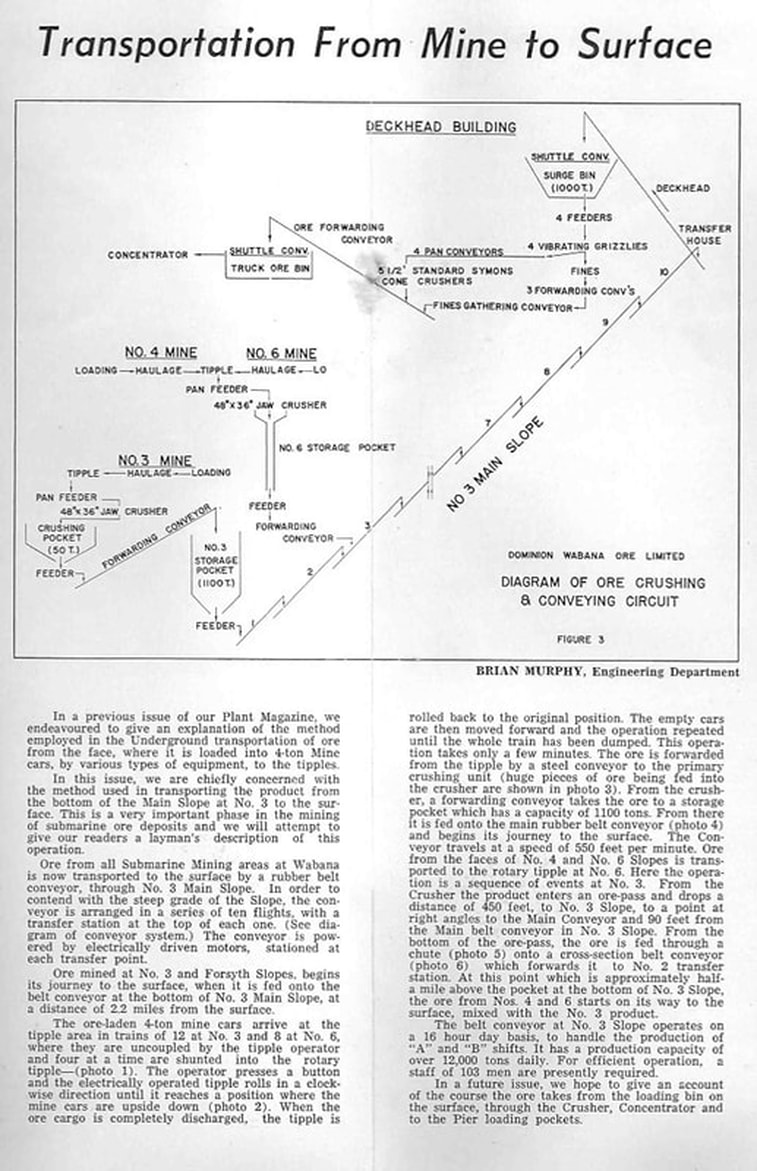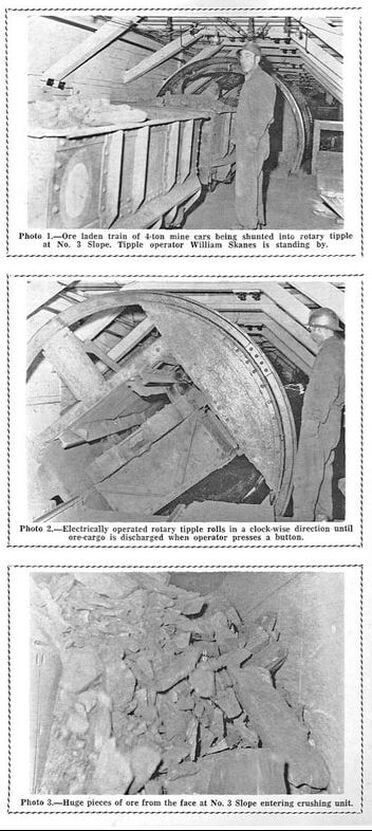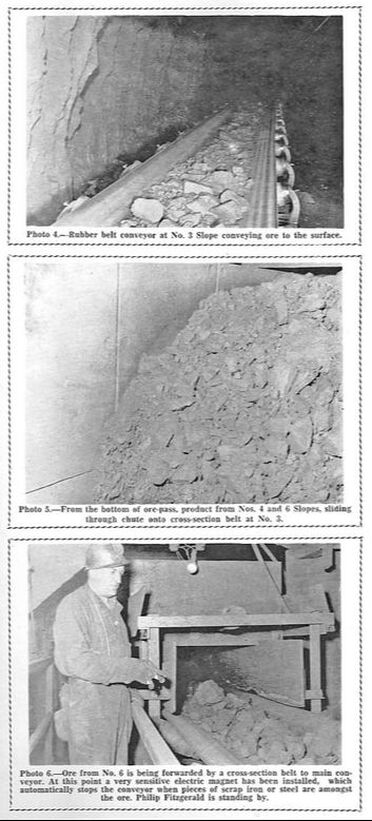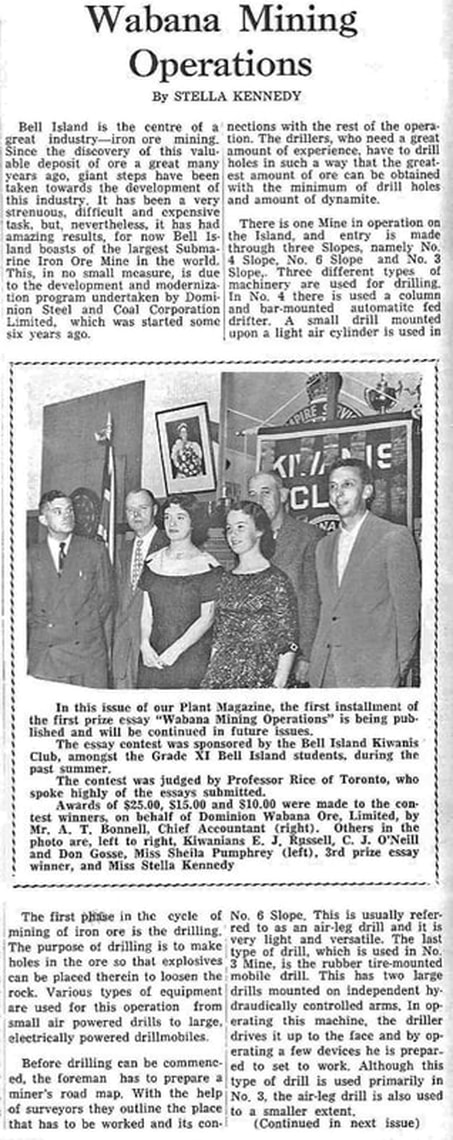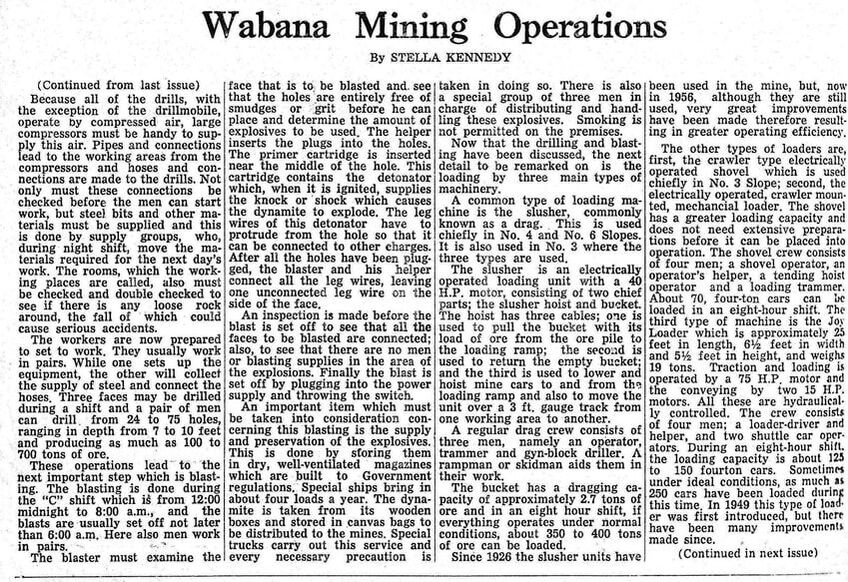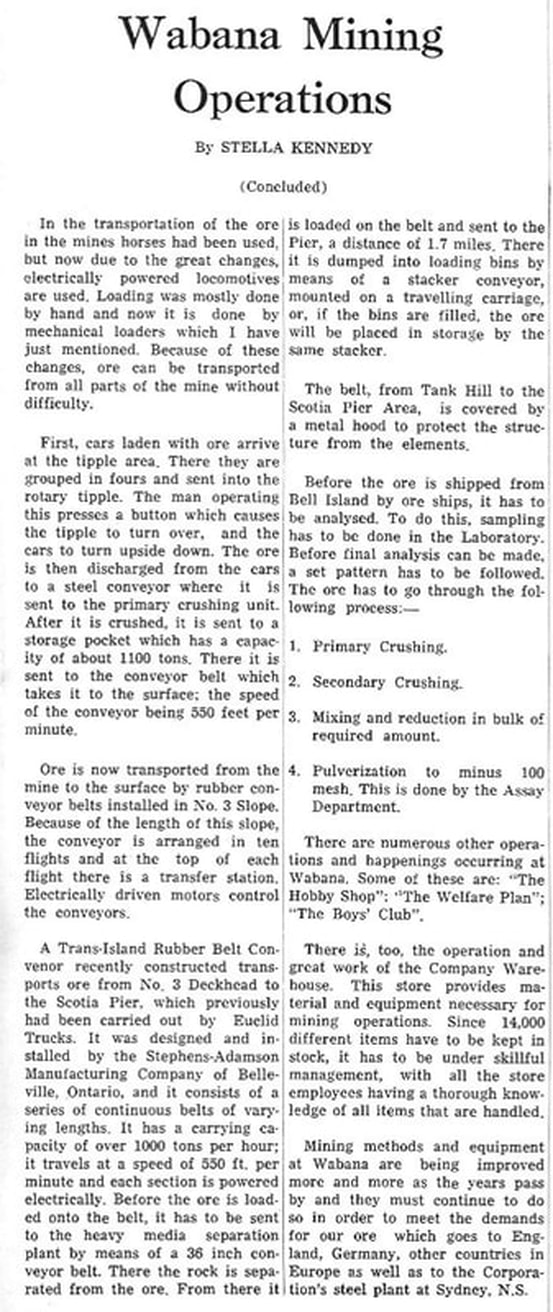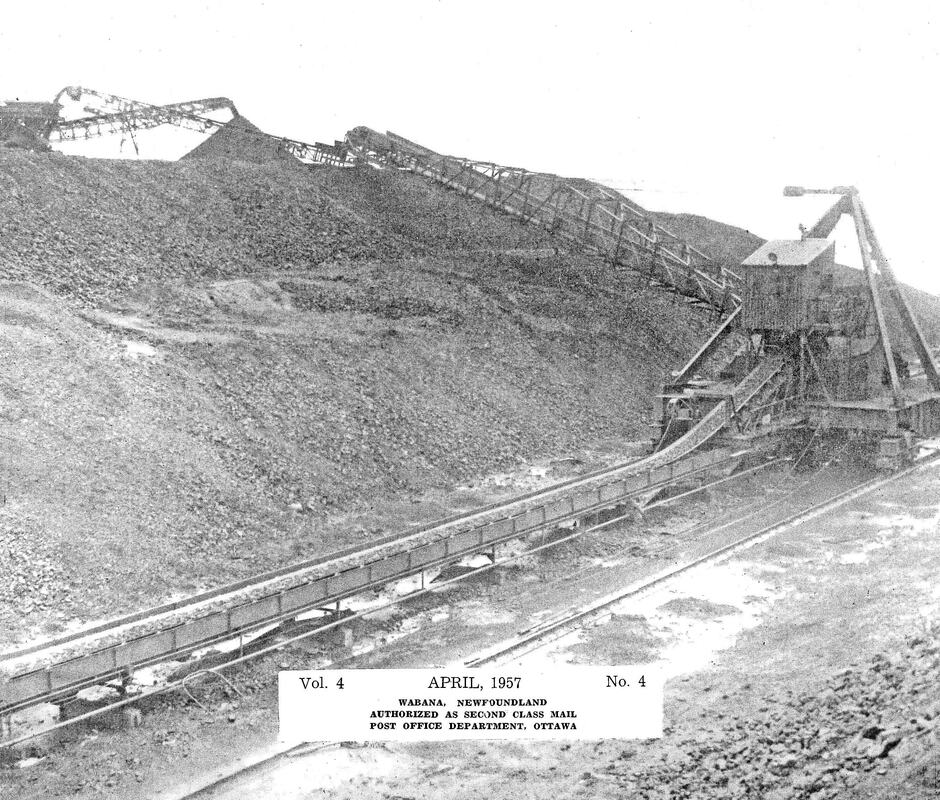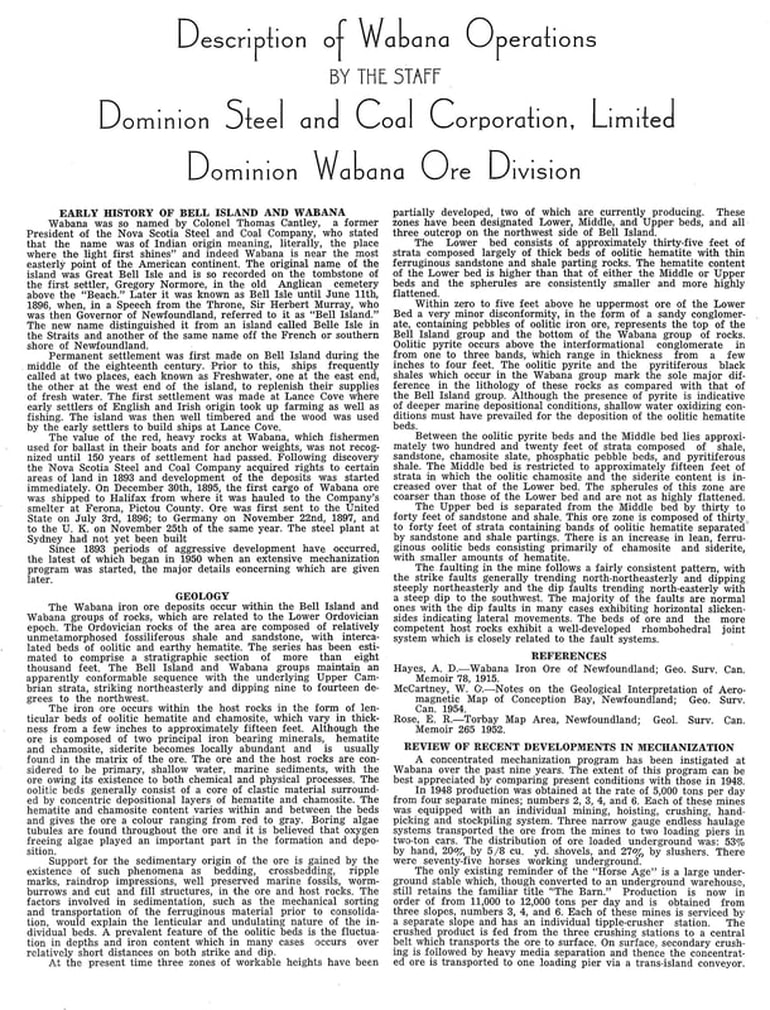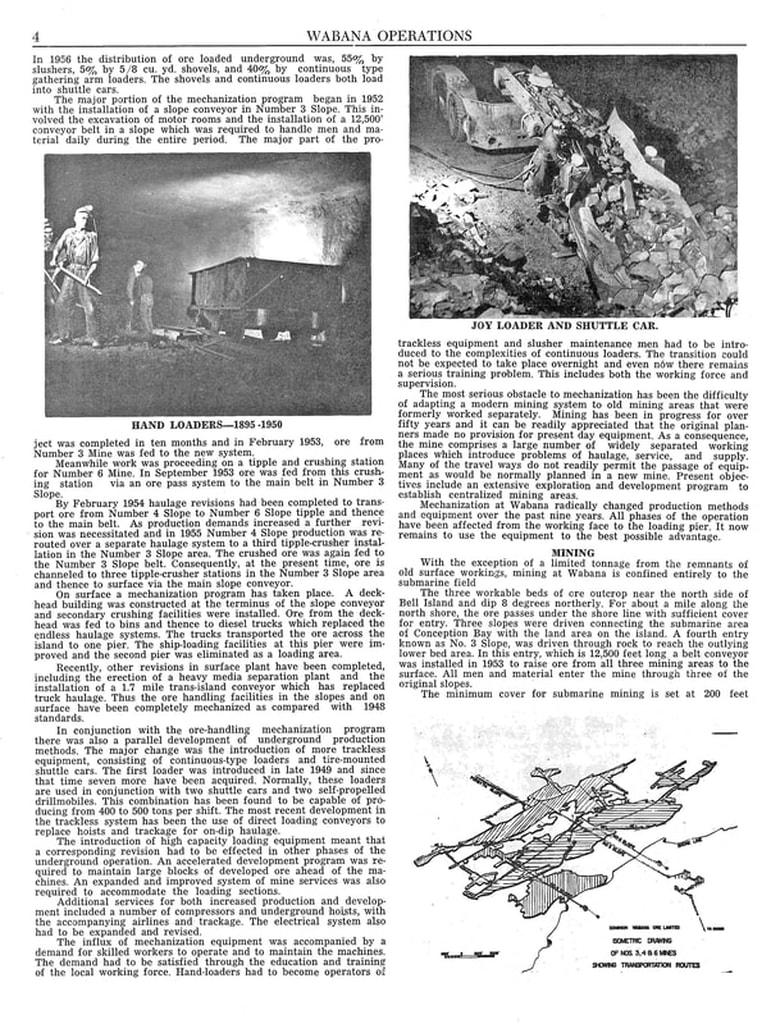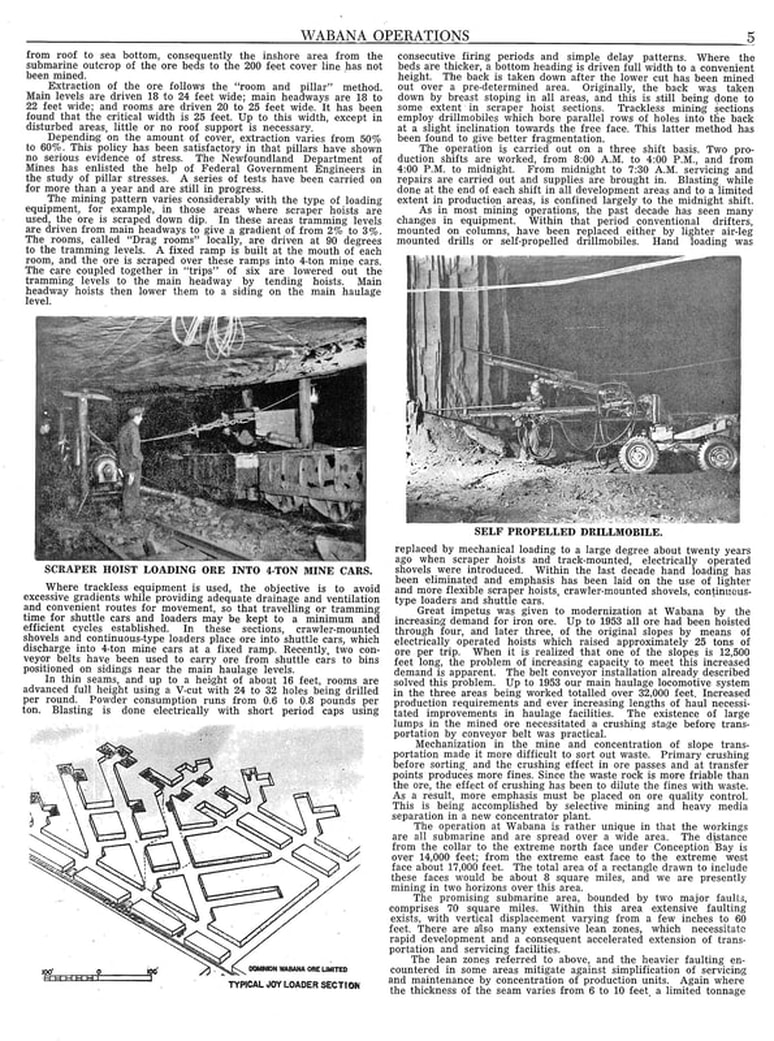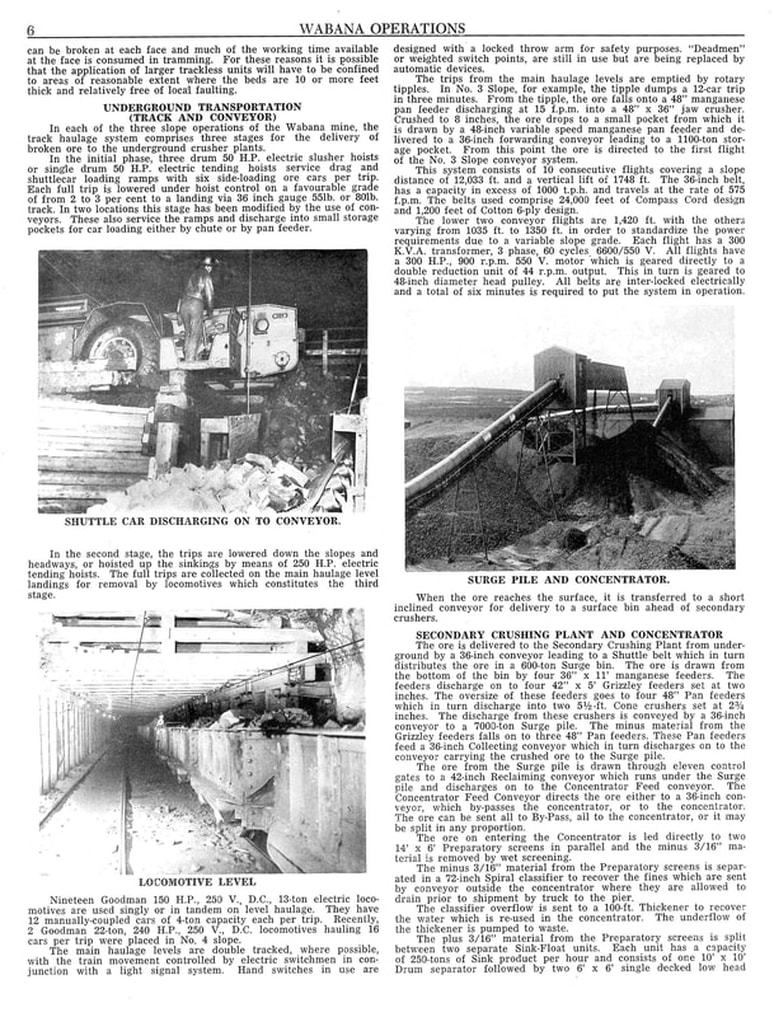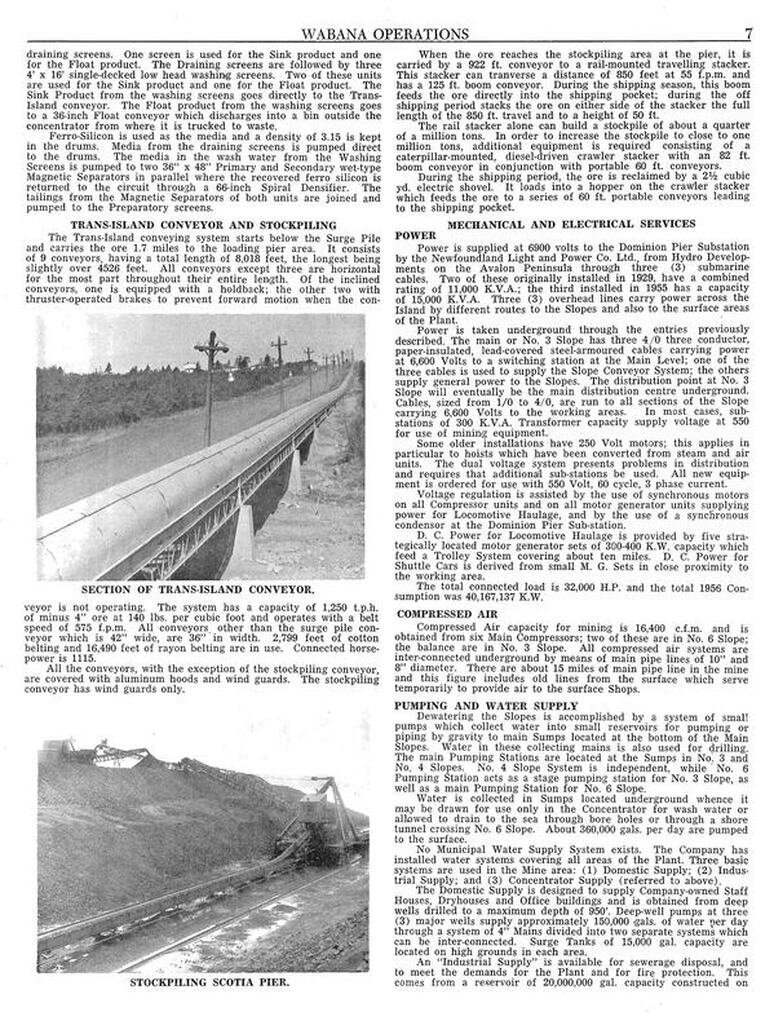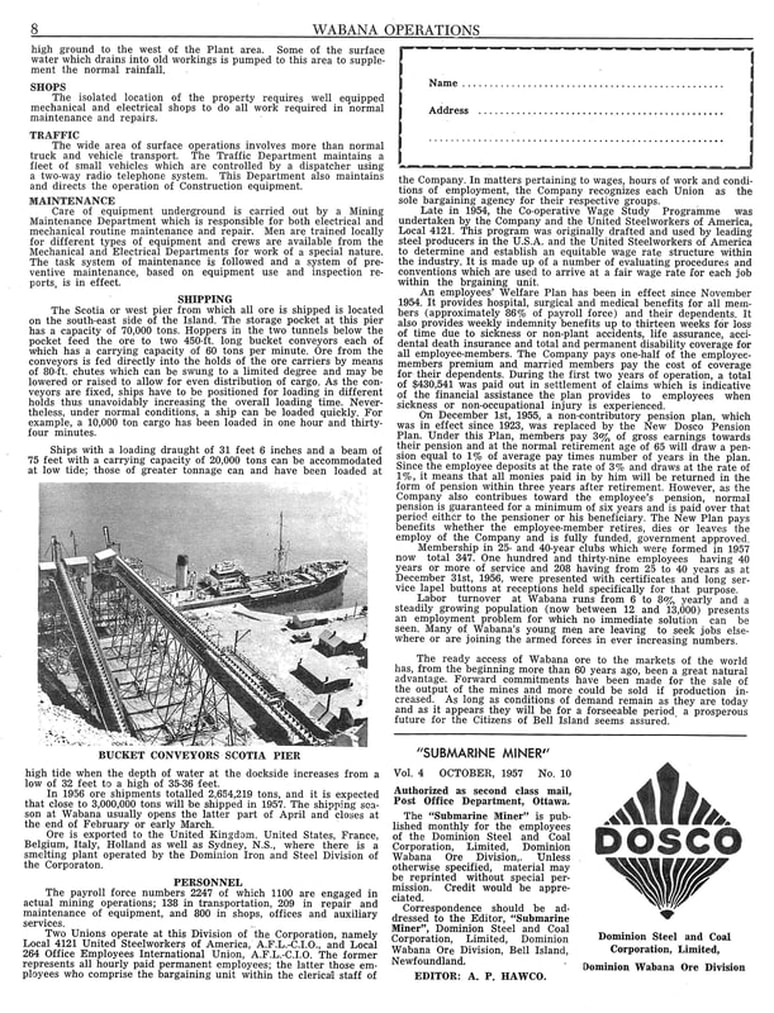Mining Operations
This page will feature descriptions of how the mining of Wabana iron ore was carried out over the years. There have been numerous articles written on this topic. I will post a few of those from the early years when mining was on the surface, then going underground, then some from the Submarine Miner, the magazine of the Dominion Wabana Ore Limited, published from 1954-1959, showing the submarine operations. Two longer articles, by Arthur House and Frederick Jardine, are posted as offshoots of this page in the drop-down menu.
The following article, "A Newfoundland Iron Deposit," by Robert E. Chambers, was published in Journal of the Canadian Mining Institute (V. 1, 1896, pages 41-52) less than a year after the first ore was shipped from Bell Island. The Scotia Company was the only mining company on the Island at that time and the mining was all on the surface. Chambers was the Chief Ore and Quarries Engineer of what would later be known at the Nova Scotia Steel and Coal Company. The Scotia Company sent Chambers to Newfoundland in 1893 to meet the Butlers of Topsail, who took him to Bell Island to assess the area. He immediately realized that the property was a valuable one and returned in 1894 to begin the work of planning the operation. By September 1895, he had begun work on building the first pier and tramway. He hired 160 men, mostly former Bell Island farmers, to begin mining surface pits on the north side of the Island. A road at the Back of Bell Island, running from Scotia No. 1 to The Green, was originally named Chambers Avenue in his honour.
The image below, from p. 47 of the original journal article, illustrates the dip of the ore bed as described above.
The image below, from p. 49 of the original journal article, illustrates the ore bed described above.
The image below, from p. 51 of the original journal article, shows the location of the Upper and Lower Beds on the North side of Bell Island, starting at Ochre Cove to the west and going east. The wording spread over the area, starting from the cliff edge and moving towards the south reads:
"Underlaid by both beds"
"Outcrop of Upper Bed"
"Underlaid by Both beds"
"Outcrop of Lower Bed."
"Underlaid by both beds"
"Outcrop of Upper Bed"
"Underlaid by Both beds"
"Outcrop of Lower Bed."
In describing "The Equipment" on pages 43-44, Chambers refers to the image below (p. 48 in the original journal article) to get "a clearer idea of this part of the plant." The labels in the image are very small and hard to read, so I have typed in larger wording.
Page 46 of the original journal article is of the Pier.
The image below, from p. 50 of the original journal article, shows Great Bell Island and the original pier, tramway and the ore outcrops. Drawing by Robert E. Chambers.
The image below, from p. 52 of the original journal article, shows the "Profile of the Wabana Tramway & Shipping Pier." I've typed in the numbers and descriptors for easier reading.
The following article, "The Sinking of the Wabana Submarine Slopes," by Robert E. Chambers and his son, A.R. Chambers, was published in Journal of the Canadian Mining Institute (V. 12, 1909, pages 139-149), 15 years after the article above was written. The iron ore deposits in the land areas had been depleted and slopes were being driven to the submarine areas by the two companies that were now operating on Bell Island. (See two longer articles, written by Arthur House and Frederick Jardine, both of whom worked for the Dominion Company, posted as offshoots of this page in the drop-down menu.)
NOTE: Before the two mining companies merged in 1922, they each had mine slopes numbering 1, 2, etc. When they merged, Dominion's No. 2 Slope (the one where the mine tours are now conducted) retained the No. 2 designation. When Chambers talks about No. 2 Slope in paragraph 4 of page 140 above, he was referring to what was Scotia's No. 2 Slope until the merger, at which time it became No. 6 Slope.
|
Note: The pages I have posted here are copied from the original published article of 1909. In the Journal's online copy of this article, there are some changes and additions to page 148:
Changes: - The end of the second paragraph continues from the original to read, "...on this land area in the beds of both companies." - Paragraph 4 online reads, "The claims of this latter company cover an area of about 33 square miles, the greater part of which is probably underlaid by iron ore." - The online version of the article ends after paragraph 4. |
Additions to page 148 in the online version of the article:
"Credit is due to the following officials of the company at Wabana, as well as their subordinates generally:
Frank Burrows, who succeeded one of the writers [ie. A.R. Chambers] as resident manager upon his taking up the designing of the permanent equipment for these slopes.
Laughlin McLean, who in the capacity of underground manager has been connected with the work from the beginning, and whose energy contributed greatly to the success.
John Cunningham, acting for the greater part of the time as mechanical superintendent, and for a short while David Fraser in the same capacity.
T.G. McKenzie, who is in charge of the surveys, and W.L. Hunter and E. Kees as draughtsmen."
"Credit is due to the following officials of the company at Wabana, as well as their subordinates generally:
Frank Burrows, who succeeded one of the writers [ie. A.R. Chambers] as resident manager upon his taking up the designing of the permanent equipment for these slopes.
Laughlin McLean, who in the capacity of underground manager has been connected with the work from the beginning, and whose energy contributed greatly to the success.
John Cunningham, acting for the greater part of the time as mechanical superintendent, and for a short while David Fraser in the same capacity.
T.G. McKenzie, who is in charge of the surveys, and W.L. Hunter and E. Kees as draughtsmen."
The diagram above is from "The Sinking of the Wabana Submarine Slopes" (above). Scotia's No. 2 Slope was renamed No. 6 Mine after the two companies merged in 1922. I have typed larger versions of most of the labels because many of the labels on the diagram are too small to read.
The following is a photo-essay on drilling methods by William Babb of No. 3 Mine, from the July 1954 issue of the Submarine Miner, pp. 5-6.
The following is a photo-essay on blasting methods, from the August 1954 issue of the Submarine Miner, pp. 4-6.
The following is the first of a 3-part photo-essay on loading methods by Leo McCarthy of No. 4 Mine, from the September 1954 issue of the Submarine Miner, pp. 4-5. Note: the text in column 3 was cut off in the original scanning of this article. I will attempt to obtain a copy of the full text when Covid-19 restrictions allow.
The following is the second of a 3-part photo-essay on loading methods by Ben Warford of No. 3 Mine, from the October 1954 issue of the Submarine Miner, pp. 4-5. Note: the text in column 3 was cut off in the original scanning of this article. I will attempt to obtain a copy of the full text when Covid-19 restrictions allow.
The following is the third of a 3-part photo-essay on loading methods by Ben Warford of No. 3 Mine, from the November 1954 issue of the Submarine Miner, pp. 4-5.
THE ERA OF THE EUCLID TRUCK SYSTEM OF TRANSPORTING IRON ORE TO SCOTIA PIER
1950-1955
1950-1955
In 1950, the Company at Wabana stopped using ore cars to transport the iron ore from the mines at the north side of the Island to the piers at the south side. In their place, they started using 20-ton Euclid trucks. As well, Dominion Pier was decommissioned as an ore loading pier; only Scotia Pier was used for loading ore from this time onward. The Euclid drivers would back the trucks up to the top of the cliff above Scotia Pier and dump the ore into the natural pocket there. At first, there was only a wooden wall above the pocket and the trucks would often knock it over. A concrete abutment was then built to solve this problem. This system was used until September 1955, when the trucks were replaced by a Trans-Island Belt Conveyor system. See the biography for Edward Thomas Byrne on the "People" page in the top menu for photos and description of the building of the concrete abutment. See photos of the Euclid trucks in operation in the Lindsay photos under "Photo Gallery" in the top menu. See photos of the Trans-Island Conveyor System and the loading system at the Scotia Pier in the Careless and Southey photos under "Photo Gallery" in the top menu.
The Trans-Island Belt Conveyor System
1955-1966
1955-1966
The following is a photo-essay on the Trans-Island Belt Conveyor that was under construction in May 1955 and featured in that month's issue of the Submarine Miner, pp. 4-5.
The following is a photo-essay by Brian Murphy of the Engineering Department on the Underground Transportation system in the submarine mines that appeared in the August 1955 issue of the Submarine Miner, pp. 4-5.
The following is a photo-essay by Brian Murphy of the Engineering Department on Transportation From Mine to Surface in the submarine mines that appeared in the October 1955 issue of the Submarine Miner, pp. 4-5.
The following essay is from the November 1956 to January 1957 issues of the Submarine Miner. It was written by Stella Kennedy, who won first prize in an essay contest for Grade XI students, sponsored by the Kiwanis Club.
Below is the cover of the April 1957 Submarine Miner, showing the new stockpiling operation at Scotia Pier. The description reads: "During the off-shipping season at Wabana, ore from the underground mining operations is placed in storage piles in the Scotia Pier area. The Trans-Island Belt Conveyor connects with the Main Stacker Unit, which operates along an 800-foot railway. The ore product is taken from the Main Stacker by Extension Stackers to a Mobile Crawler-type Stacker, which operates along top of the ore pile. More than three quarters of a million tons of iron ore were placed in storage at Wabana during the past winter."
The following article is from the October 1957 issue of the Submarine Miner, pp. 3-8. It gives a little of the early history and the geology, then goes into detail of the operations in the final few decades of the mines.
